Yamaha CVP-207, CVP-209 User Manual
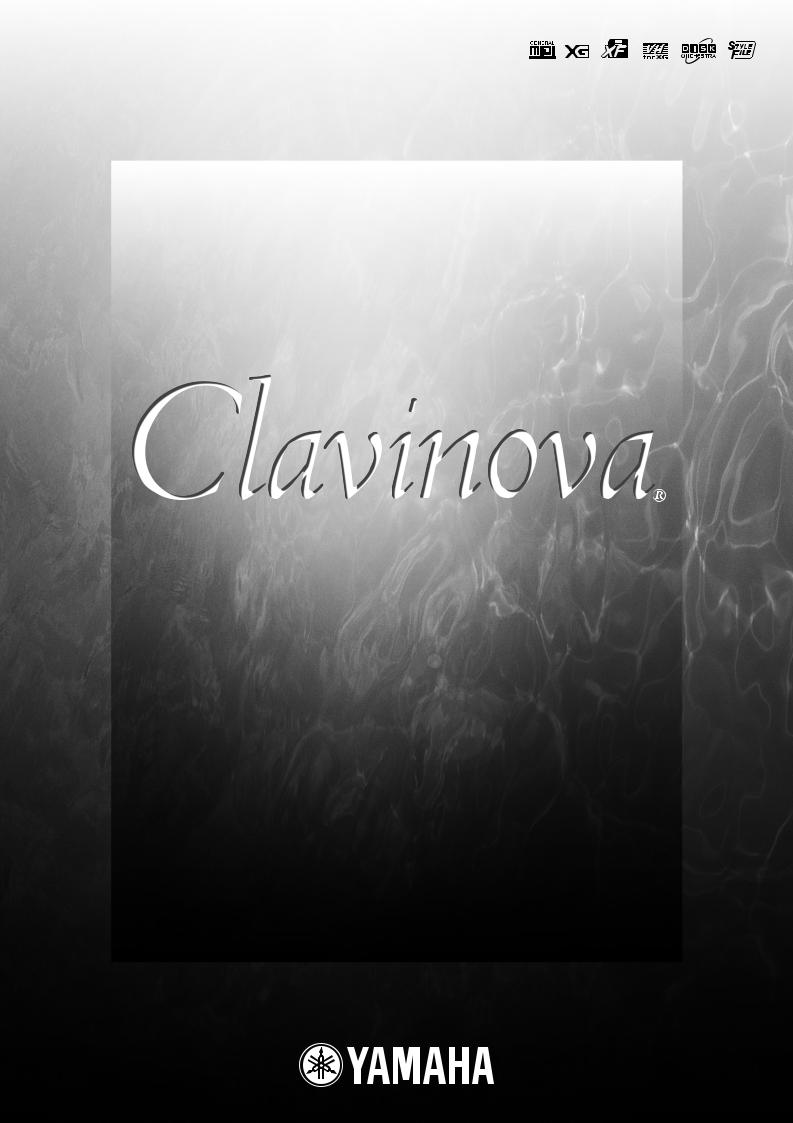
CVP-209/207
OWNER’S’S MANUAL
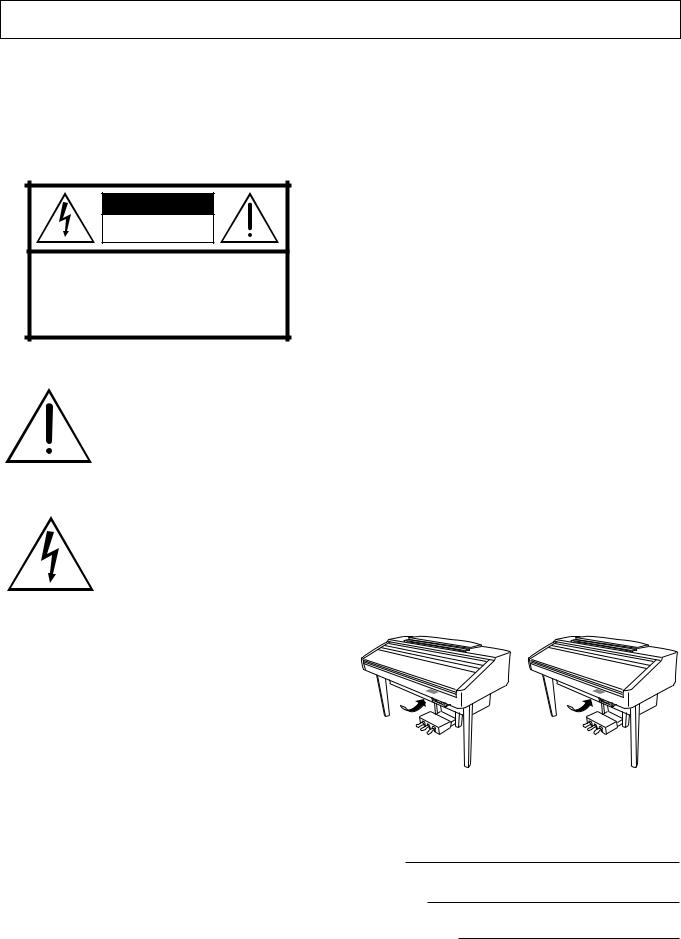
SPECIAL MESSAGE SECTION
PRODUCT SAFETY MARKINGS: Yamaha electronic products may have either labels similar to the graphics shown below or molded/stamped facsimiles of these graphics on the enclosure. The explanation of these graphics appears on this page. Please observe all cautions indicated on this page and those indicated in the safety instruction section.
CAUTION |
RISK OF ELECTRIC SHOCK |
DO NOT OPEN |
CAUTION: TO REDUCE THE RISK OF ELECTRIC SHOCK. |
DO NOT REMOVE COVER (OR BACK). |
NO USER-SERVICEABLE PARTS INSIDE. |
REFER SERVICING TO QUALIFIED SERVICE PERSONNEL. |
See bottom of Keyboard enclosure for graphic symbol markings.
The exclamation point within the equilateral triangle is intended to alert the user to the presence of important operating and maintenance (servicing) instructions in the literature accompanying the product.
The lightning flash with arrowhead symbol, within the equilateral triangle, is intended to alert the user to the presence of uninsulated “dangerous voltage” within the product’s enclosure that may be of sufficient magnitude to constitute a risk of electrical shock.
IMPORTANT NOTICE: All Yamaha electronic products are tested and approved by an independent safety testing laboratory in order that you may be sure that when it is properly installed and used in its normal and customary manner, all foreseeable risks have been eliminated. DO NOT modify this unit or commission others to do so unless specifically authorized by Yamaha. Product performance and/or safety standards may be diminished. Claims filed under the expressed warranty may be denied if the unit is/has been modified. Implied warranties may also be affected.
SPECIFICATIONS SUBJECT TO CHANGE: The information contained in this manual is believed to be correct at the time of printing. However, Yamaha reserves the right to change or modify any of the specifications without notice or obligation to update existing units.
ENVIRONMENTAL ISSUES: Yamaha strives to produce products that are both user safe and environmentally friendly. We sincerely believe that our products and the production methods used to produce them, meet these goals. In keeping with both the letter and the spirit of the law, we want you to be aware of the following:
Battery Notice: This product MAY contain a small nonrechargable battery which (if applicable) is soldered in place. The average life span of this type of battery is approximately five years. When replacement becomes necessary, contact a qualified service representative to perform the replacement.
Warning: Do not attempt to recharge, disassemble, or incinerate this type of battery. Keep all batteries away from children. Dispose of used batteries promptly and as regulated by applicable laws. Note: In some areas, the servicer is required by law to return the defective parts. However, you do have the option of having the servicer dispose of these parts for you.
Disposal Notice: Should this product become damaged beyond repair, or for some reason its useful life is considered to be at an end, please observe all local, state, and federal regulations that relate to the disposal of products that contain lead, batteries, plastics, etc.
NOTICE: Service charges incurred due to lack of knowledge relating to how a function or effect works (when the unit is operating as designed) are not covered by the manufacturer’s warranty, and are therefore the owners responsibility. Please study this manual carefully and consult your dealer before requesting service.
NAME PLATE LOCATION: The graphic below indicates the location of the name plate. The model number, serial number, power requirements, etc., are located on this plate. You should record the model number, serial number, and the date of purchase in the spaces provided below and retain this manual as a permanent record of your purchase.
CVP-209 |
CVP-207 |
Model
Serial No.
Purchase Date
92-469 1 (bottom)
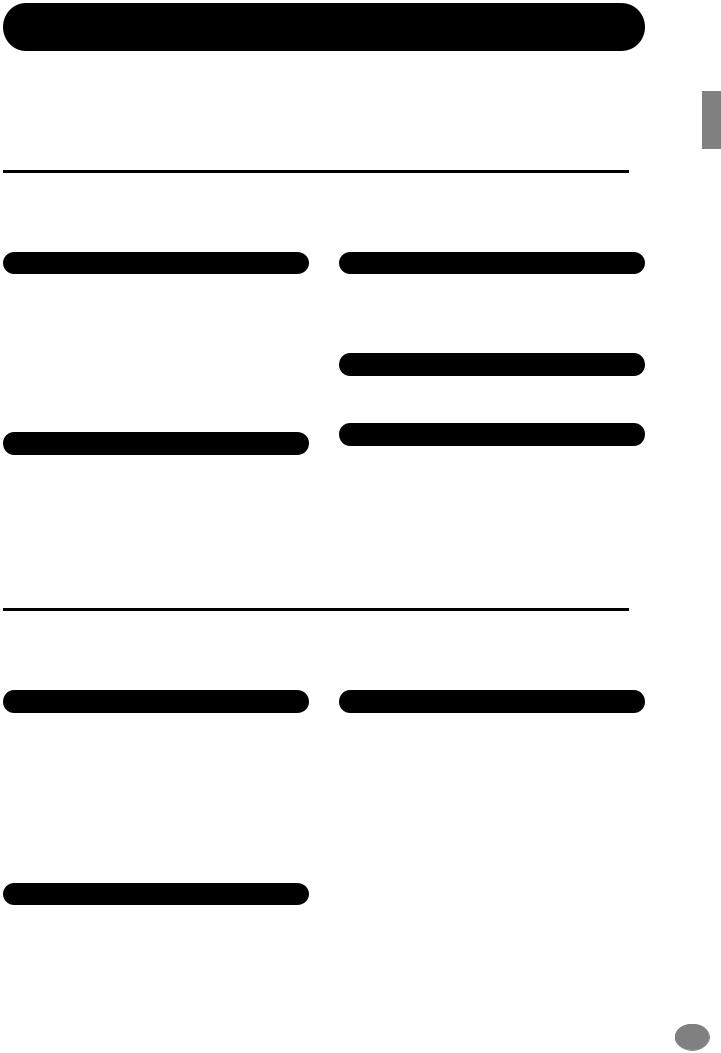
PRECAUTIONS
PLEASE READ CAREFULLY BEFORE PROCEEDING
* Please keep this manual in a safe place for future reference.
 WARNING
WARNING
Always follow the basic precautions listed below to avoid the possibility of serious injury or even death from electrical shock, short-circuiting, damages, fire or other hazards. These precautions include, but are not limited to, the following:
Power supply/Power cord
•Only use the voltage specified as correct for the instrument. The required voltage is printed on the name plate of the instrument.
•Check the electric plug periodically and remove any dirt or dust which may have accumulated on it.
•Use only the supplied power cord/plug.
•Do not place the power cord near heat sources such as heaters or radiators, and do not excessively bend or otherwise damage the cord, place heavy objects on it, or place it in a position where anyone could walk on, trip over, or roll anything over it.
Water warning
•Do not expose the instrument to rain, use it near water or in damp or wet conditions, or place containers on it containing liquids which might spill into any openings.
•Never insert or remove an electric plug with wet hands.
Fire warning
•Do not put burning items, such as candles, on the unit. A burning item may fall over and cause a fire.
Do not open
•Do not open the instrument or attempt to disassemble the internal parts or modify them in any way. The instrument contains no user-serviceable parts. If it should appear to be malfunctioning, discontinue use immediately and have it inspected by qualified Yamaha service personnel.
If you notice any abnormality
•If the power cord or plug becomes frayed or damaged, or if there is a sudden loss of sound during use of the instrument, or if any unusual smells or smoke should appear to be caused by it, immediately turn off the power switch, disconnect the electric plug from the outlet, and have the instrument inspected by qualified Yamaha service personnel.
 CAUTION
CAUTION
Always follow the basic precautions listed below to avoid the possibility of physical injury to you or others, or damage to the instrument or other property.These precautions include, but are not limited to, the following:
Power supply/Power cord
•When removing the electric plug from the instrument or an outlet, always hold the plug itself and not the cord. Pulling by the cord can damage it.
•Remove the electric plug from the outlet when the instrument is not to be used for extended periods of time, or during electrical storms.
•Do not connect the instrument to an electrical outlet using a mul- tiple-connector.
Doing so can result in lower sound quality, or possibly cause overheating in the outlet.
Assembly
•Read carefully the attached documentation explaining the assembly process.
Failure to assemble the instrument in the proper sequence might result in damage to the instrument or even injury.
Location
•Do not expose the instrument to excessive dust or vibrations, or extreme cold or heat (such as in direct sunlight, near a heater, or in a car during the day) to prevent the possibility of panel disfiguration or damage to the internal components.
•Do not use the instrument in the vicinity of a TV, radio, stereo equipment, mobile phone, or other electric devices. Otherwise, the instrument, TV, or radio may generate noise.
•Do not place the instrument in an unstable position where it might accidentally fall over.
•Before moving the instrument, remove all connected cables. Also check that all screws are tight and have not been loosened by moving the instrument.
•Do not place the instrument against a wall (allow at least 3 cm/ one-inch from the wall), since this can cause inadequate air circulation, and possibly result in the instrument overheating.
(1)B-7 1/2
CVP-209/207 3
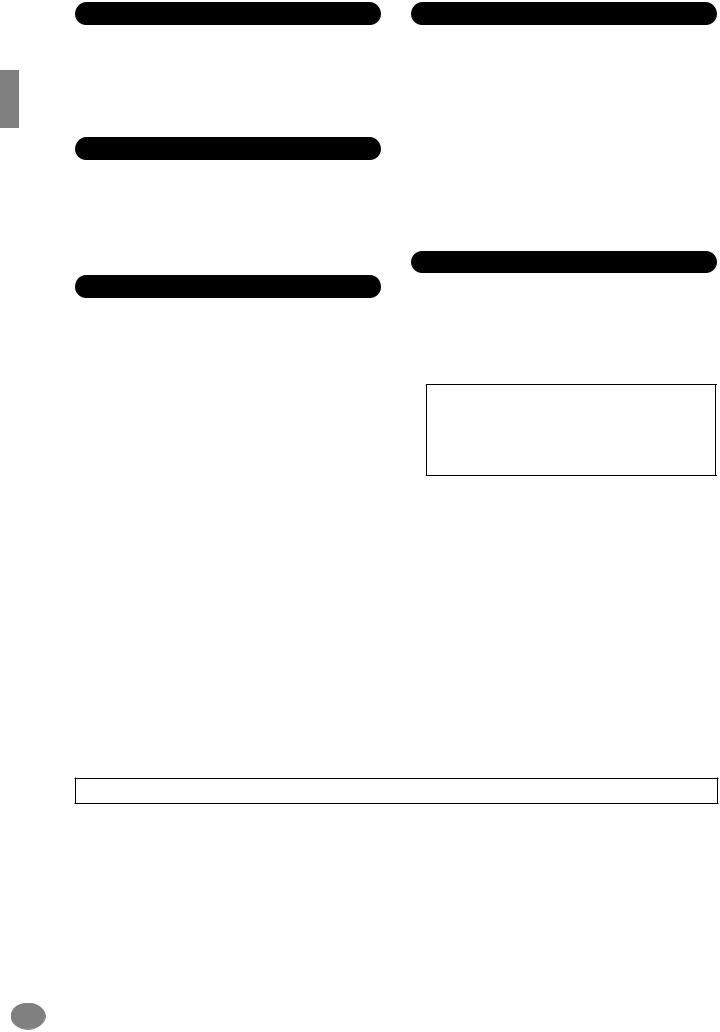
Connections
•Before connecting the instrument to other electronic components, turn off the power for all components. Before turning the power on or off for all components, set all volume levels to minimum. Also, be sure to set the volumes of all components at their minimum levels and gradually raise the volume controls while playing the instrument to set the desired listening level.
Maintenance
•On the CVP-209, gently remove dust and dirt with a soft cloth. Do not wipe too hard since small particles of dirt can scratch the instrument's finish.
•When cleaning the instrument, use a soft, dry or slightly damp cloth. Do not use paint thinners, solvents, cleaning fluids, or chemical-impregnated wiping cloths.
Handling caution
•Take care that the key cover does not pinch your fingers, and do not insert a finger or hand in any gaps on the key cover or instrument.
•Never insert or drop paper, metallic, or other objects into the gaps on the key cover, panel or keyboard. If this happens, turn off the power immediately and unplug the power cord from the AC outlet. Then have the instrument inspected by qualified Yamaha service personnel.
•Do not place vinyl, plastic or rubber objects on the instrument, since this might discolor the panel or keyboard.
•On the CVP-209, bumping the surface of the instrument with metal, porcelain, or other hard objects can cause the finish to crack or peel. Use caution.
•Do not rest your weight on, or place heavy objects on the instrument, and do not use excessive force on the buttons, switches or connectors.
•Do not operate the instrument for a long period of time at a high or uncomfortable volume level, since this can cause permanent hearing loss. If you experience any hearing loss or ringing in the ears, consult a physician.
Using the bench (If included)
•Do not place the bench in an unstable position where it might accidentally fall over.
•Do not play carelessly with or stand on the bench. Using it as a tool or step-ladder or for any other purpose might result in accident or injury.
•Only one person should sit on the bench at a time, in order to prevent the possibility of accident or injury.
•On the CVP-209 bench, do not attempt to adjust the bench height while sitting on the bench, since this can cause excessive force to be imposed on the adjustment mechanism, possibly resulting in damage to the mechanism or even injury.
•If the bench screws become loose due to extensive long-term use, tighten them periodically using the included tool.
Saving data
Saving and backing up your data
•Current memory data (see page 40) is lost when you turn off the power to the instrument. Save the data to a floppy disk/the User Drive (see page 40).
Saved data may be lost due to malfunction or incorrect operation. Save important data to a floppy disk.
When you change settings in a display page and then exit from that page, System Setup data (listed in the Parameter Chart of the separate Data List booklet) is automatically stored. However, this edited data is lost if you turn off the power without properly exiting from the relevant display.
Backing up the floppy disk
•To protect against data loss through media damage, we recommend that you save your important data onto two floppy disks.
Yamaha cannot be held responsible for damage caused by improper use or modifications to the instrument, or data that is lost or destroyed.
Always turn the power off when the instrument is not in use.
(1)B-7 2/2
4 CVP-209/207
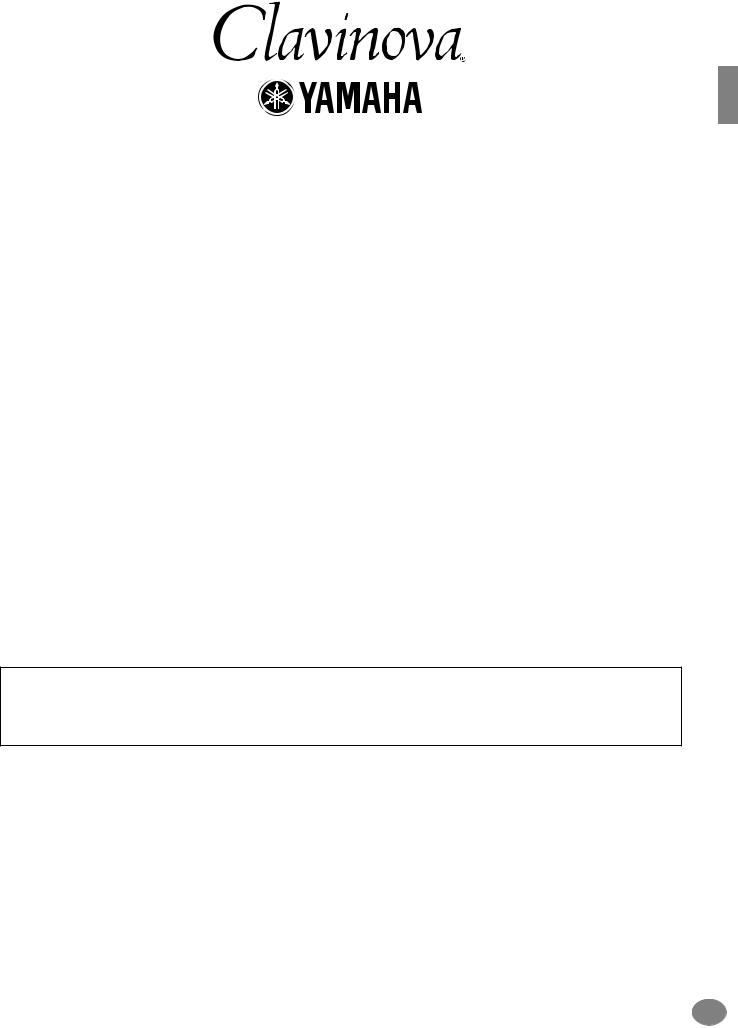
Thank you for purchasing the Yamaha Clavinova! We recommend that you read this manual carefully so that you can fully take advantage of the advanced and convenient functions of the Clavinova.
We also recommend that you keep this manual in a safe and handy place for future reference.
About this Owner’s Manual and Data List
This manual consists of four main sections: Introduction, Quick Guide, Basic Operation, and Reference. Also, a separate Data List is provided.
Introduction (page 2): Please read this section first.
Quick Guide (page 20): This section explains how to use the basic functions.
Basic Operation (page 39): This section explains how to use the basic operations including display-based controls. Reference (page 53): This section explains how to make detailed settings for the Clavinova’s various functions.
Data List : Voice List, MIDI Data Format, etc.
*The models CVP-209/207 will be referred to as the CVP/Clavinova in this Owner’s Manual.
*The illustrations and LCD screens as shown in this owner’s manual are for instructional purposes only, and may appear somewhat different from those on your instrument.
*The example Operation Guide displays shown in this Manual are taken from the CVP-209, and in English.
*Copying of the commercially available software is strictly prohibited except for your personal use.
This product incorporates and bundles computer programs and contents in which Yamaha owns copyrights or with respect to which it has license to use others’ copyrights. Such copyrighted materials include, without limitation, all computer software, styles files, MIDI files, WAVE data and sound recordings. Any unauthorized use of such programs and contents outside of personal use is not permitted under relevant laws. Any violation of copyright has legal consequences. DON’T MAKE, DISTRIBUTE OR USE ILLEGAL COPIES.
Trademarks:
•Apple and Macintosh are trademarks of Apple Computer, Inc.
•IBM-PC/AT is a trademark of International Business Machines Corporation.
•Windows is the registered trademark of Microsoft® Corporation.
•All other trademarks are the property of their respective holders.
*The photos of the harpsichord, bandoneon, hackbrett, music box, dulcimer and cimbalom, shown in the displays of the CVP209/207, are courtesy of the Gakkigaku Shiryokan (Collection for Organolgy), Kunitachi College of Music.
*The following instruments, shown in the displays of the CVP-209/207, are on display at the Hamamatsu Museum of Musical Instruments: balafon, gender, kalimba, kanoon, santur, gamelan gong, harp, hand bell, bagpipe, banjo, carillon, mandolin, oud, pan flute, pungi, rabab. shanai, sitar, steel drum, tambra.
*This product is manufactured under license of U.S. Patents No.5231671, No.5301259, No.5428708, and No.5567901 from IVL Technologies Ltd.
*The bitmap fonts used in this instrument have been provided by and are the property of Ricoh Co., Ltd.
CVP-209/207 5
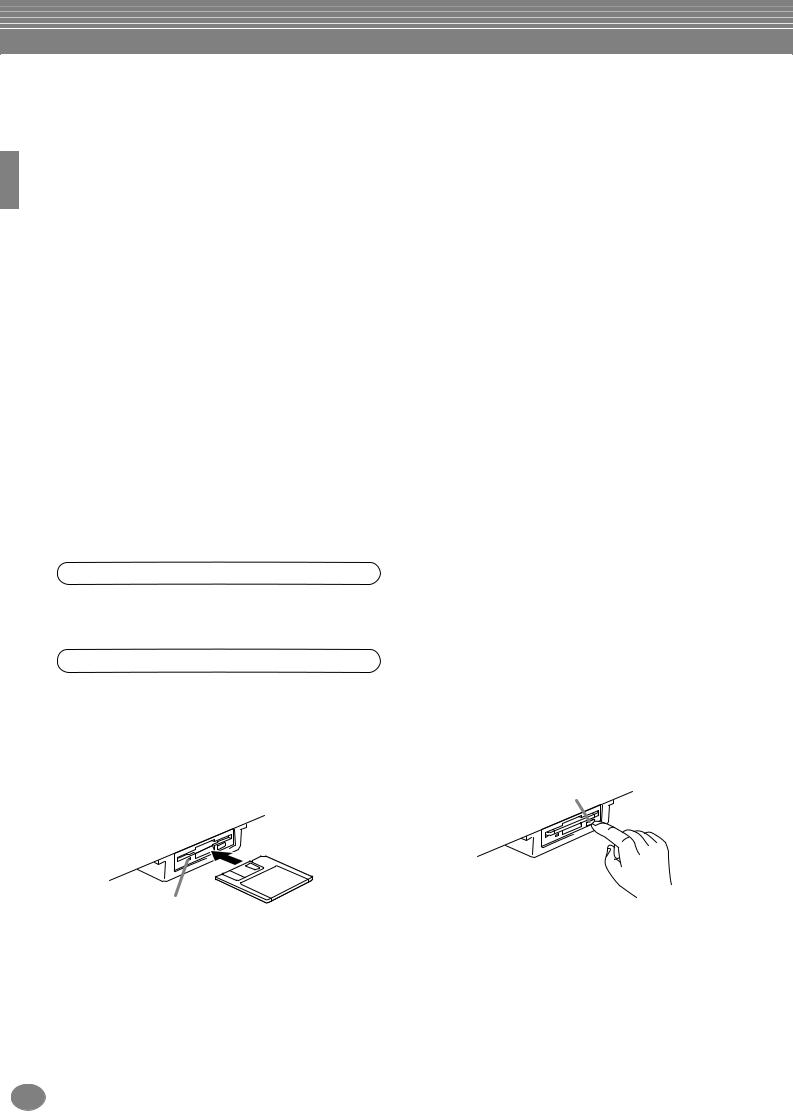
Accessories
■“50 greats for the Piano” Disk (and Music Book)
■Recording disk
Use this blank disk to save your performance.
■Owner’s Manual
This manual contains complete instructions for operating your Clavinova.
■Data List
This manual contains lists of voices, styles and parameters, etc.
■Bench
A bench may be included or optional, depending on your locale.
Handling the Floppy Disk Drive (FDD) and
Floppy Disk
Precautions
Be sure to handle floppy disks and treat the disk drive with care. Follow the important precautions below.
Compatible Disk Type
• 3.5" 2DD and 2HD type floppy disks can be used.
Inserting/Ejecting Floppy Disks
To insert a floppy disk into the disk drive:
•Hold the disk so that the label of the disk is facing upward and the sliding shutter is facing forward, towards the disk slot. Carefully insert the disk into the slot, slowly pushing it all the way in until it clicks into place and the eject button pops out.
To eject a floppy disk:
Before ejecting the disk, be sure to confirm that data is not being written to the floppy disk.
If data is currently being written to the floppy disk in the following operations, the messages “Now executing,” “Now copying,” and “Now formatting” appears in the display.
•Moving, copying, pasting, saving, or deleting data (page 43 - 45).
•Naming files and folders (page 42); creating a new folder (page 45).
•Copying a disk to an another disk (page 150); formatting the disk (page 150).
Eject button
Drive lamp
When the power is turned on, the drive lamp (at the bottom left of the drive) lights to indicate the drive can be used.
6 CVP-209/207
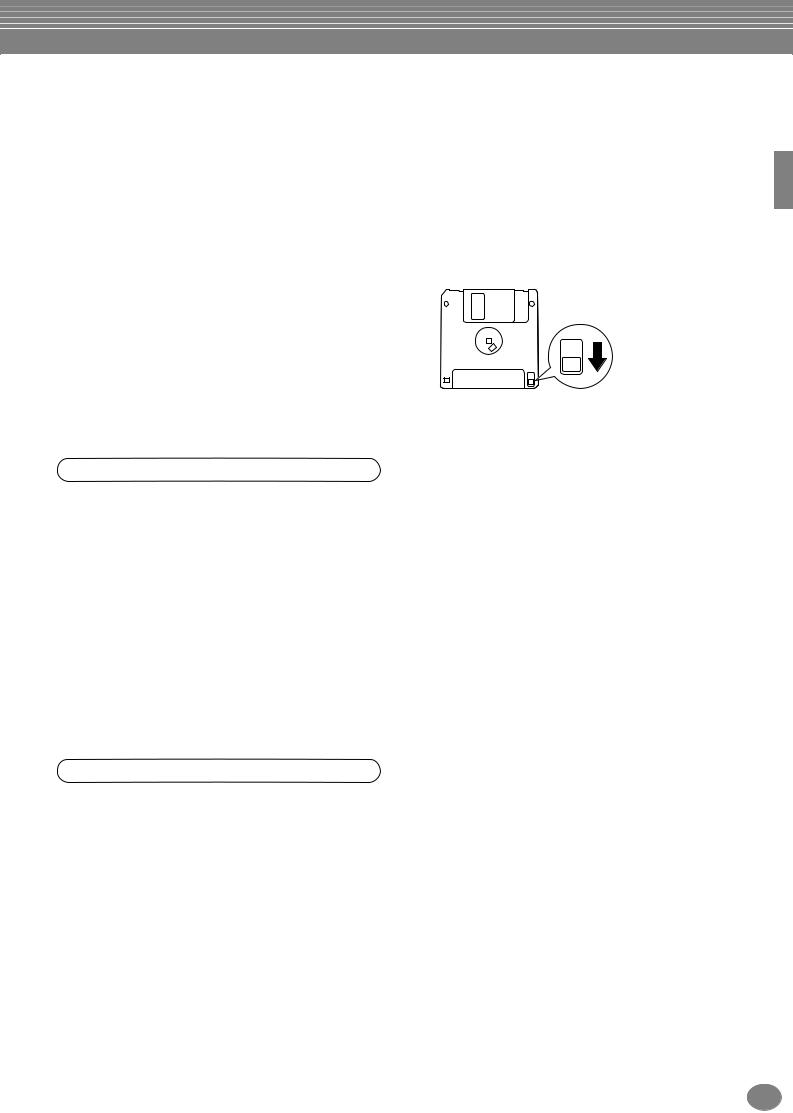
•Never attempt to remove the disk or turn the power off when the data is being written to the floppy disk. Doing so can damage the disk and possibly the disk drive. Press the eject button slowly as far as it will go; the disk will automatically pop out. When the disk is fully ejected, carefully remove it by hand.
•If the eject button is pressed too quickly, or if it is not pressed in as far as it will go, the disk may not eject properly. The eject button may become stuck in a halfpressed position with the disk extending from the drive slot by only a few millimeters. If this happens, do not attempt to pull out the partially ejected disk, since using force in this situation can damage the disk drive mechanism or the floppy disk. To remove a partially ejected disk, try pressing the eject button once again, or push the disk back into the slot and then repeat the eject procedure.
•Be sure to remove the floppy disk from the disk drive before turning off the power. A floppy disk left in the drive for extended periods can easily pick up dust and dirt that can cause data read and write errors.
Cleaning the Disk Drive Read/Write Head
•Clean the read/write head regularly. This instrument employs a precision magnetic read/write head which, after an extended period of use, will pick up a layer of magnetic particles from the disks used that will eventually cause read and write errors.
•To maintain the disk drive in optimum working order Yamaha recommends that you use a commerciallyavailable dry-type head cleaning disk to clean the head about once a month. Ask your Yamaha dealer about the availability of proper head-cleaning disks.
•Never insert anything but floppy disks into the disk drive. Other objects may cause damage to the disk drive or floppy disks.
About the Floppy Disks
To handle floppy disks with care:
•Do not place heavy objects on a disk or bend or apply pressure to the disk in any way. Always keep floppy disks in their protective cases when they are not in use.
•Do not expose the disk to direct sunlight, extremely high or low temperatures, or excessive humidity, dust or liquids.
•Do not open the sliding shutter and touch the exposed surface of the floppy disk inside.
•Do not expose the disk to magnetic fields, such as those produced by televisions, speakers, motors, etc., since magnetic fields can partially or completely erase data on the disk, rendering it unreadable.
•Never use a floppy disk with a deformed shutter or housing.
•Do not attach anything other than the provided labels to a floppy disk. Also make sure that labels are attached in the proper location.
To protect your data (Write-protect Tab):
•To prevent accidental erasure of important data, slide the disk’s write-protect tab to the “protect” position (tab open).
write-protect tab open (protect position)
Data backup
•For maximum data security Yamaha recommends that you keep two copies of important data on separate floppy disks. This gives you a backup if one disk is lost or damaged. To make a backup disk use the Disk to Disk function on page 150.
CVP-209/207 7
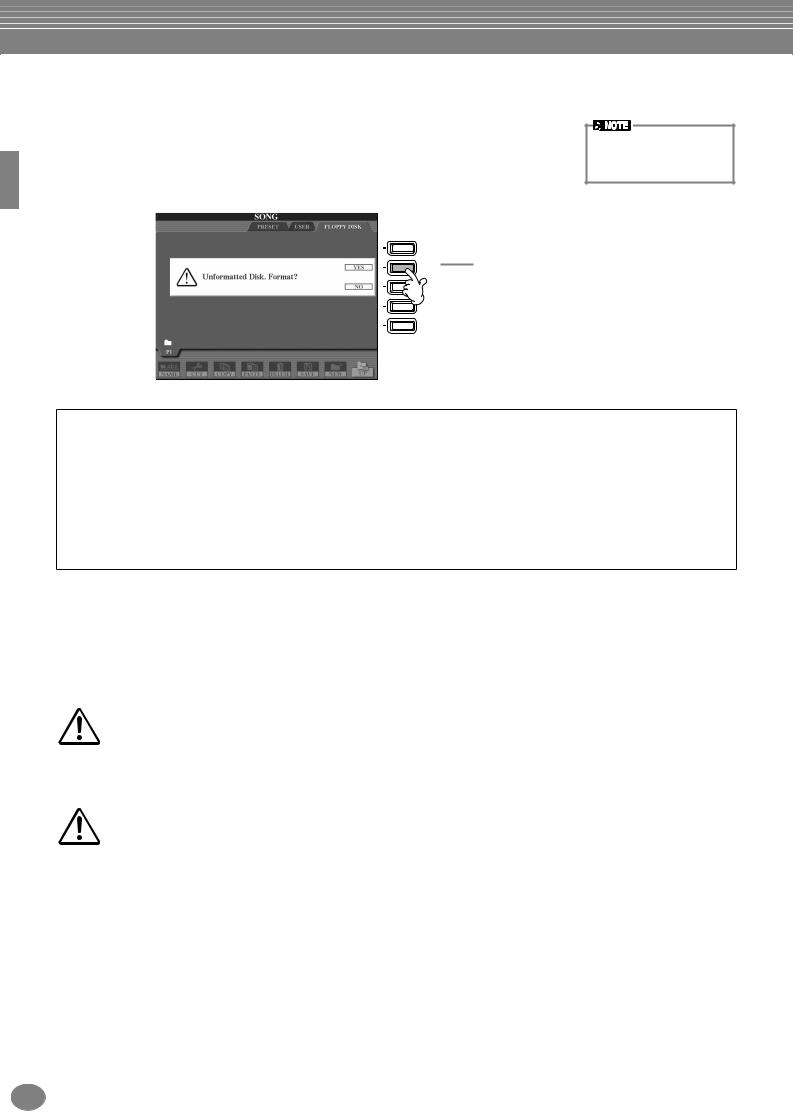
About the Display Messages
A message (information or confirmation dialog) sometimes appears on the screen to facilitate operation.
When such messages appear, simply follow the instructions as shown by pressing the corresponding button.
You can select the desired language from the Help display (page 50).
F
G
H
For this example, press the
[G] (YES) button to execute formatting.
I
J
“The Clavinova-Computer Connection” is a supplementary guidebook that describes, for beginners, what you can do with your Clavinova and a personal computer and how to set up a Clavinova-Computer system (the manual is not written for any specific models). The document is available as a PDF file (in English) at the following Internet address:
Clavinova Home Page.......................... |
http://www.yamahaclavinova.com/ |
Yamaha Manual Library |
|
(Electronic Musical Instruments) ......... |
http://www2.yamaha.co.jp/manual/english/ |
Maintenance
Clean the instrument using a dry, soft cloth or slightly damp, soft cloth (wring well).
CAUTION
Do not use benzine, thinner, detergent, or chemical cloth for cleaning. Do not place vinyl, plastic, or rubber products on the instrument.
Otherwise, the panel or keys may be discolored or degraded.
CAUTION
Before using the Clavinova, be sure to read “Precautions” on pages 3 - 4.
■Tuning
Unlike an acoustic piano, the Clavinova does not need to be tuned. It always stays perfectly in tune.
■Transporting
If you move to another location, you can transport the Clavinova along with other belongings. You can move the unit as it is (assembled) or you can disassemble the unit down to the condition it was in when you first took it out of the box. Transport the keyboard horizontally. Do not lean it up against a wall or stand it up on its side.
Do not subject the instrument to excessive vibration or shock.
When transporting the assembled Clavinova, make sure all screws are properly tightened and have not been loosened by moving the instrument.
8 CVP-209/207

Table of Contents
Introduction |
|
SPECIAL MESSAGE SECTION ................................... |
2 |
PRECAUTIONS .......................................................... |
3 |
About this Owner’s Manual and Data List .............. |
5 |
Accessories ............................................................... |
6 |
Handling the Floppy Disk Drive (FDD) |
|
and Floppy Disk..................................................... |
6 |
About the Display Messages.................................... |
8 |
Maintenance ............................................................ |
8 |
Application Index ................................................... |
12 |
What can you do with the Clavinova?................... |
14 |
Setting Up the Clavinova ....................................... |
16 |
Panel Controls and Terminals................................ |
18 |
Quick Guide ........................... |
20 |
Playing the Demos ................................................. |
20 |
Song Playback ........................................................ |
21 |
Playback of Songs .................................................... |
21 |
Playing Voices ........................................................ |
25 |
Playing a Voice ........................................................ |
25 |
Playing Two Voices Simultaneously .......................... |
26 |
Playing Different Voices with the Left and Right Hands .... |
27 |
Playing Styles ......................................................... |
28 |
Playing a style .......................................................... |
28 |
Style Sections........................................................... |
30 |
One Touch Setting................................................... |
32 |
Music Finder........................................................... |
33 |
Using the Music Finder ............................................ |
33 |
Searching the Music Finder Records......................... |
34 |
Playing and Practicing with the Songs.................. |
36 |
Playing Along with the Clavinova............................. |
36 |
Recording ................................................................ |
37 |
Mastering Your Favorite Songs................................. |
38 |
Basic Operations |
|
— Organizing Your Data ....... |
39 |
Selecting Files and Folders..................................... |
41 |
File/Folder-related Operations .............................. |
42 |
Naming Files/Folders ............................................... |
42 |
Moving Files/Folders ................................................ |
43 |
Copying Files/Folders............................................... |
44 |
Deleting Files/Folders............................................... |
44 |
Saving Files .............................................................. |
45 |
Organizing Files by Creating a New Folder .............. |
45 |
Displaying Upper Level pages .................................. |
45 |
Entering Characters and Changing Icons ................. |
45 |
Using the [DATA ENTRY] Dial................................ |
47 |
Direct Access — Instant Selection of Displays....... |
48 |
Help Messages ....................................................... |
50 |
Using the Metronome............................................ |
51 |
Adjusting the Tempo ............................................. |
51 |
Tap Tempo .............................................................. |
52 |
Reference |
|
Playing the Demos................. |
53 |
Voices..................................... |
55 |
Selecting a Voice .................................................... |
55 |
One-touch Piano Play.............................................. |
56 |
Layer/Left — Playing Several Sounds |
|
Simultaneously .................................................... |
57 |
Layer — Layering Two Different Voices ................... |
57 |
Left — Setting Separate Voices for the Left |
|
and Right Sections of the Keyboard ..................... |
58 |
Applying Voice Effects ........................................... |
58 |
Using the Pedals..................................................... |
59 |
Styles...................................... |
60 |
Playing a style ........................................................ |
60 |
Adjusting the Volume Balance/Channel Muting ...... |
62 |
Chord Fingerings.................................................... |
63 |
Arranging the Style Pattern (SECTIONS: |
|
MAIN A/B/C/D, INTRO, ENDING, BREAK) ......... |
65 |
Stopping the Style Playback While Releasing Keys |
|
(SYNC. STOP) ...................................................... |
66 |
Selecting Intro and Ending Types |
|
(INTRO/ENDING) ................................................ |
67 |
Playing Fill-in patterns automatically when changing |
|
accompaniment sections — Auto Fill In................ |
67 |
Appropriate Panel Setting for the Selected Style |
|
(ONE TOUCH SETTING) ...................................... |
68 |
Automatically Changing One Touch Settings |
|
with the Sections — OTS Link .............................. |
69 |
Registering the Panel Controls in One Touch |
|
Setting (ONE TOUCH SETTING)........................... |
69 |
Calling Up Ideal Setups for Your Music |
|
— Music Finder.................................................... |
70 |
Searching the Ideal Setups — Music Finder Search .... |
71 |
Editing Records — Music Finder Record Edit ........... |
72 |
Song Playback........................ |
74 |
Compatible Song Types ......................................... |
74 |
Song Playback ........................................................ |
75 |
Playing the Internal Songs....................................... |
75 |
Playing Back Songs on Disk..................................... |
77 |
Other Playback-related Operations.......................... |
77 |
Muting Specific Parts |
|
— Track1/Track2/Extra Tracks ............................ |
78 |
Repeat Playback of a Specific Range ..................... |
78 |
Using the Practice Functions —Guide ................... |
79 |
Practice Functions ................................................... |
79 |
Practicing Music with the Guide Functions.............. |
80 |
Displaying Music Notation — Score ...................... |
81 |
Displaying the Lyrics .............................................. |
84 |
CVP-209/207 9

Saving and Recalling Custom |
|
Panel Setups |
|
— Registration Memory ........ |
85 |
Registering Panel Setups |
|
— Registration Memory...................................... |
85 |
Saving Your Registration Memory Setups ................. |
86 |
Recalling a Registration Memory Setup ................ |
87 |
Editing Voices |
|
— Sound Creator ................... |
88 |
Operation ............................................................... |
88 |
SOUND CREATOR Parameters |
|
(Natural/Regular Voices) .................................... |
89 |
Organ Flutes........................................................... |
93 |
Operation ............................................................... |
93 |
Recording Your Performances |
|
and Creating Songs |
|
— Song Creator ..................... |
94 |
About Song Recording........................................... |
94 |
Quick Recording..................................................... |
95 |
Multi Recording ..................................................... |
96 |
Recording Individual Notes — Step Record .......... |
98 |
Operation ................................................................ |
98 |
Recording Melodies — Step Record (Note) ............ |
100 |
Recording Chord Changes for the Auto |
|
Accompaniment — Step Record (Chord) ............ |
101 |
Select the Recording Options: Starting, |
|
Stopping, Punching In/Out — Rec Mode......... |
103 |
Editing a Recorded Song ..................................... |
104 |
Editing Channel-related Parameters — Channel ..... |
104 |
Editing Note Events — 1 - 16................................. |
107 |
Editing Chord Events — CHD................................. |
108 |
Editing System Events — SYS/EX. |
|
(System Exclusive) .............................................. |
108 |
Inputting and Editing Lyrics ................................... |
109 |
Customizing the Event List — Filter........................ |
109 |
Creating Accompaniment Styles |
|
— Style Creator ................... |
110 |
About Creating Accompaniment Styles .............. |
110 |
Style File Format .................................................. |
111 |
Operation ............................................................. |
111 |
Realtime Recording — Basic ................................ |
112 |
Step Recording..................................................... |
113 |
Assembling an Accompaniment Style |
|
—Assembly ........................................................ |
114 |
Edit the Created Accompaniment Style .............. |
115 |
Change the Rhythmic Feel |
|
— Groove and Dynamics.................................... |
115 |
Editing the Channel Data....................................... |
117 |
Making Style File Format Settings —Parameter ...... |
118 |
Adjust the Volume Balance and |
|
Changing Voices |
|
— Mixing Console ................ |
120 |
Operation ............................................................. |
120 |
Setting the Level Balance and Voice |
|
— Volume/Voice ............................................... |
121 |
Changing the Tone of the Voice — Filter............ |
122 |
Changing Pitch-related Settings — Tune ............ |
122 |
Adjusting the Effects ............................................ |
123 |
Adjusting the Sound to Match the Performance |
|
Environment — EQ............................................ |
125 |
Effect Structure ..................................................... |
126 |
Using a Microphone — MIC. 128 |
|
Selecting a Vocal Harmony Type ......................... |
128 |
Adjusting the Vocal Harmony Settings and Microphone |
|
Effects — OVERALL SETTING.............................. |
130 |
Making Settings for the Vocal Harmony and |
|
Microphone — MICROPHONE SETTING .......... |
130 |
Setting the Microphone Volume and Related Effects |
|
— TALK SETTING............................................... |
132 |
Making Global and Other |
|
Important Settings |
|
— Function........................... |
133 |
Operation ............................................................. |
133 |
Fine Tuning the Pitch/Selecting a Scale |
|
— Master Tune/Scale Tune............................... |
135 |
Tuning the Overall Pitch — Master Tune............... |
135 |
Selecting a Scale — Scale Tune ............................. |
135 |
Setting Song-related Parameters |
|
— Song Settings................................................ |
137 |
Setting Auto Accompaniment-related Parameters |
|
— Style Setting, Split Point, |
|
and Chord Fingering......................................... |
138 |
Setting Auto Accompaniment-related Parameters — |
|
Style Setting and Split Point............................... |
138 |
Setting the Fingering Method |
|
— Chord Fingering ............................................ |
139 |
Making Settings for the Pedals and Keyboard |
|
— Controller...................................................... |
139 |
Making Settings for the Pedals .............................. |
139 |
Changing the Touch Sensitivity and Transpose |
|
— Keyboard/Panel ............................................. |
141 |
Setting the Registration Sequence, Freeze, and |
|
Voice Set............................................................ |
142 |
Specifying the Order for Calling Up Registration |
|
Memory Presets — Registration Sequence.......... |
142 |
Maintaining Panel Settings — Freeze .................... |
142 |
Changing the Automatically Selected Voice Settings |
|
— Voice Set ....................................................... |
143 |
Setting Harmony and Echo.................................. |
143 |
10 CVP-209/207
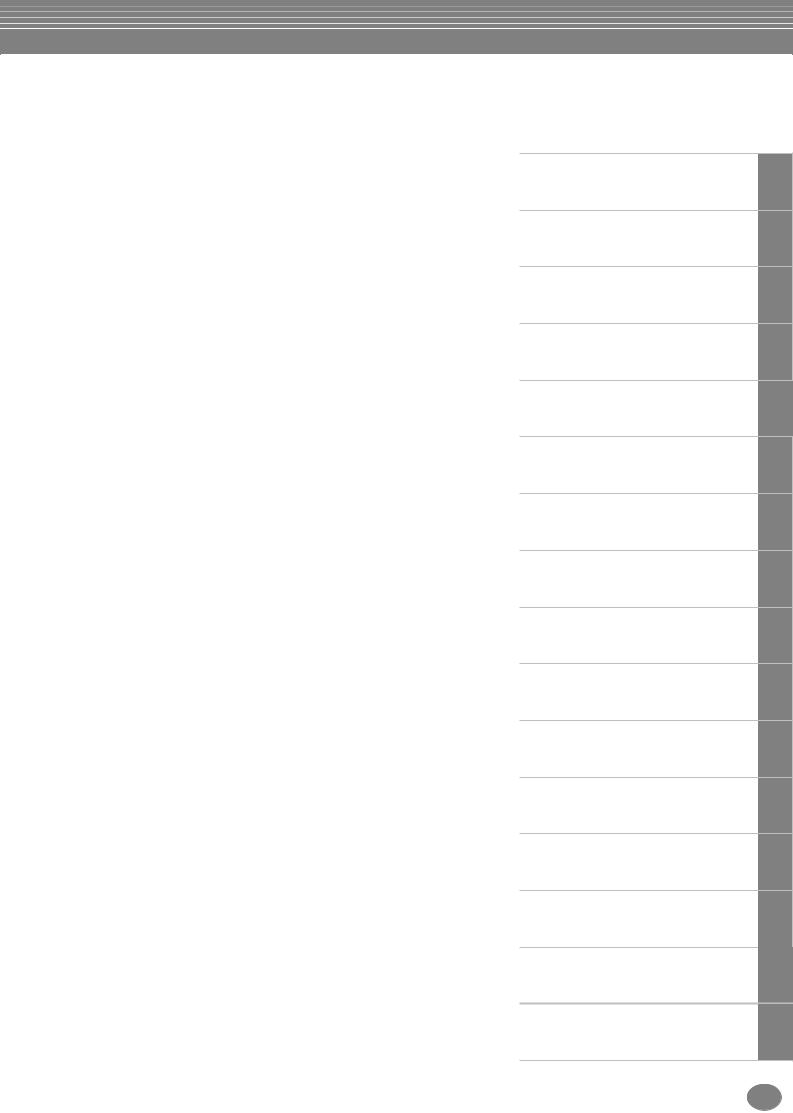
Showing the Clavinova Display on a TV |
|
— Video Out...................................................... |
144 |
Setting the MIDI Parameters ............................... |
145 |
Making Overall System Settings |
|
(Local Control, Clock, etc.) — System................. |
145 |
Transmitting MIDI Data — Transmit ...................... |
146 |
Receiving MIDI Data — Receive ............................. |
147 |
Setting Root Note Channels — Root ...................... |
147 |
Setting Chord Channels — Chord Detect .............. |
147 |
Other Settings — Utility ...................................... |
148 |
Making Settings for Fade In/Out, Metronome, |
|
Parameter Lock, and Tap — CONFIG 1............... |
148 |
Making Settings for the Display, Speaker System, |
|
and Voice Number Indication — CONFIG 2........ |
149 |
Copying and Formatting Disks — Disk................... |
150 |
Entering Your Name and Language Preference |
|
— Owner............................................................ |
151 |
Restoring the Factory-programmed Settings of the |
|
CVP-209/207 — System Reset ............................ |
151 |
Using Your Clavinova |
|
with Other Devices.............. |
152 |
Using the Headphones (PHONES jacks).................. |
152 |
Connecting the Microphone or Guitar |
|
(MIC./LINE IN jack)............................................. |
152 |
Connecting Audio & Video Devices ....................... |
153 |
Using the Pedal (footswitch) or Foot Controller |
|
(AUX PEDAL jack) ............................................... |
154 |
Connecting external MIDI devices |
|
(MIDI terminals) ................................................. |
154 |
Connecting to a Computer |
|
(MIDI terminals/TO HOST terminal).................... |
154 |
What’s MIDI?......................................................... |
156 |
What You Can Do With MIDI................................. |
158 |
Data Compatibility............................................... |
159 |
Disk format ............................................................ |
159 |
Sequence Format................................................... |
159 |
Voice Allocation Format ......................................... |
160 |
CVP-209/207: Keyboard |
|
Stand Assembly ................... |
161 |
Troubleshooting.................. |
163 |
Specifications ...................... |
165 |
Index ................................... |
167 |
Introduction
Quick Guide
Basic Operations - Organizing Your Data
Playing the Demos
Voices
Styles
Song Playback
Saving and Recalling Custom
Panel Setups - Registration Memory
Editing Voices - Sound Creator
Recording Your Performances
and Creating Songs - Song Creator
Creating Accompaniment Styles
- Style Creator
Adjust the Volume Balance
and Changing Voices - Mixing Console
Using a Microphone - MIC.
Making Global and Other Important
Settings - Function
Using Your Clavinova with Other Devices
Appendix
CVP-209/207 11
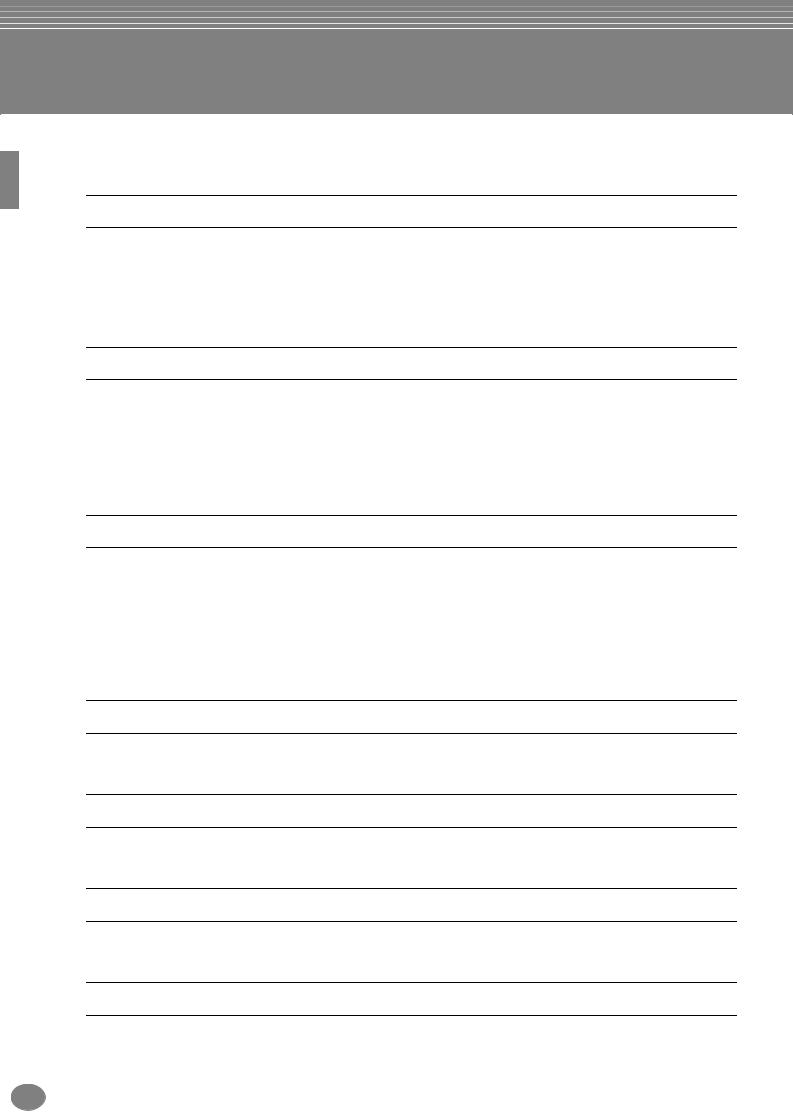
Application Index
Use this index to find reference pages that may be helpful for your particular application and situation.
Listening
Listening to the internal songs ................................................................................................................ |
page 75 |
Listening to disk songs ....................................................................... |
“Playing Back Songs on Disk” on page 77 |
Listening to demo songs......................................................................................................................... |
page 53 |
Listening to the demo of the selected voices .......................................................................................... |
page 55 |
Listening to songs with the special voices of the Clavinova .................................................................. |
page 121 |
Playing
Calling up the piano setting ................................................................................................................... |
page 56 |
Using the three performance control pedals........................................................................................... |
page 59 |
Playing an accompaniment that matches pitch............................................................. |
“Transpose ”on page 141 |
Combining two voices ...................................................... |
“Layer — Layering Two Different Voices” on page 57 |
Playing separate voices with the right and left hands
...........................“Left — Setting Separate Voices for the Left and Right Sections of the Keyboard” on page 58
Changing the sound
Enhancing the sound with reverb and other effects |
.....................................“Applying Voice Effects” on page 58 |
|
“Adjusting the Effects” on page 123 |
Adjusting the Level Balance ................................................................................................................. |
page 121 |
Combining two voices ...................................................... |
“Layer — Layering Two Different Voices” on page 57 |
Playing separate voices with the right and left hands
...........................“Left — Setting Separate Voices for the Left and Right Sections of the Keyboard” on page 58 Creating voices ...................................................................................................................................... page 88
Playing the auto accompaniment
Playing the accompaniment automatically............................................................................................. |
page 60 |
Calling up ideal panel settings for your music ........................................................................................ |
page 70 |
Practicing
Muting the rightor left-hand part .......................................................................................................... |
page 80 |
Practicing with an accurate and steady tempo............................................. |
“Using the Metronome” on page 51 |
Recording
Recording your performance........................................................................................................... |
pages 95, |
96 |
Creating a song by entering notes .......................................................................................................... |
page |
98 |
Creating your original settings
Creating voices ...................................................................................................................................... |
page 88 |
Creating accompaniment styles............................................................................................................ |
page 110 |
12 CVP-209/207
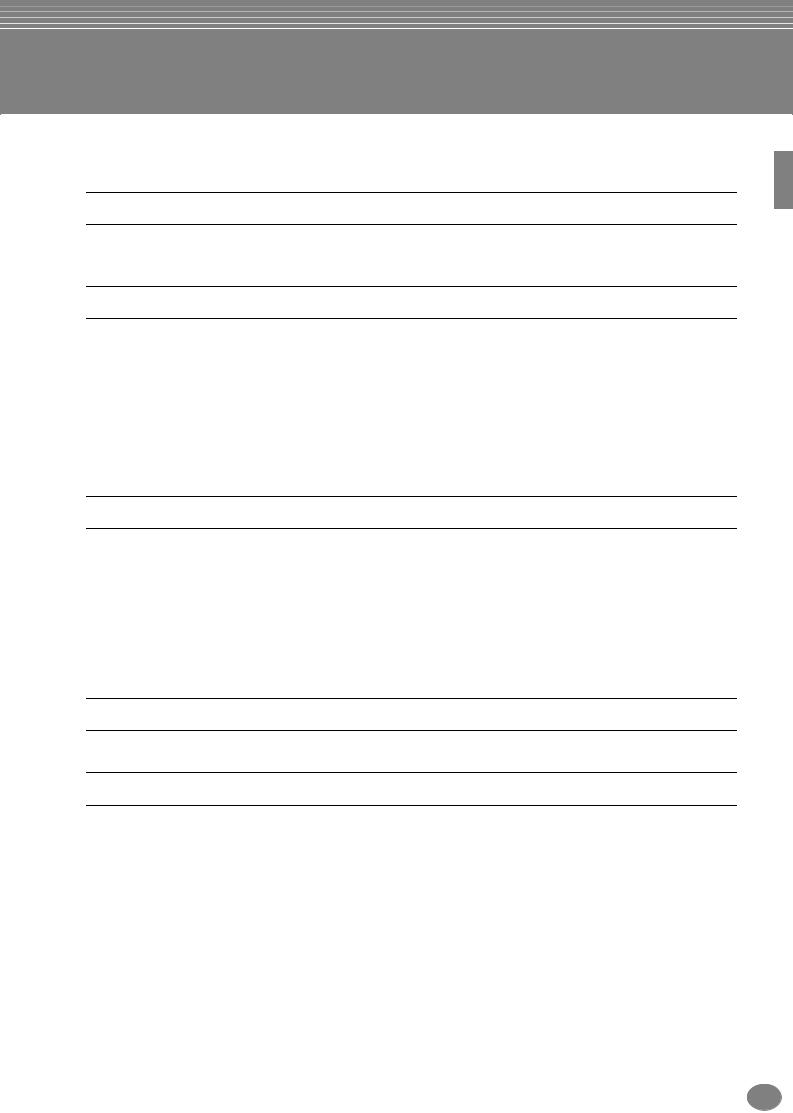
Using a microphone
Connecting the microphone.............. |
”Connecting the Microphone or Guitar (MIC./LINE IN jack)” on page 152 |
|
Adding automatic harmonies to your singing ....................................................................................... |
page 128 |
|
Settings
Registering Panel Setups......................................................................................................................... |
|
page 85 |
Tuning the pitch/Selecting a scale ........................................................................................................ |
|
page 135 |
Making detailed settings for playing back songs ................................................................................... |
page 137 |
|
Making detailed settings for the auto accompaniment.......................................................................... |
page 138 |
|
Making settings for the pedals ....................................................... |
|
“Making Settings for the Pedals” on page 139 |
Making detailed settings for the keyboard voices ................................................................................. |
page 141 |
|
Showing the display on a TV .................... |
“Showing the Clavinova Display on a TV — Video Out” on page 144 |
|
Making detailed settings for MIDI ........................................................................................................ |
|
page 145 |
Connecting the Clavinova to other devices
Basic information on MIDI..................................................................................... |
|
“What’s MIDI?” on page 156 |
Recording your performance................ |
”Playing the sounds of the Clavinova through an external audio system, |
|
|
and recording the sounds to an external recorder (AUX OUT jacks)” on page 153 |
|
Raising the volume .............................. |
”Playing the sounds of the Clavinova through an external audio system, |
|
|
and recording the sounds to an external recorder (AUX OUT jacks)” on page 153 |
|
Outputting another instrument’s sound from the Clavinova ............ |
”Outputting the sound of an external device |
|
|
through the built in speakers of the Clavinova (AUX IN jacks)” on page 153 |
|
Connecting a computer........... |
.”Connecting to a Computer (MIDI terminals/TO HOST terminals)” on page 154 |
|
Assembling
Assembling and disassembling the Clavinova...............“CVP-209/207: Keyboard Stand Assembly” on page 161
Quick solution
Basic functions of the Clavinova and how you can best use it .........................................................pages 12, 14 Resetting the Clavinova to the default setting
.................... “Restoring the Factory-programmed Settings of the CVP-209/207 — System Reset” on page 151
Displaying the Messages ...................................................................... |
“About the Display Messages” on page 8 |
Adjusting the contrast/brightness.......................................... |
.”Making Settings for the Display, Speaker System, |
|
and Voice Number Indication – CONFIG 2” on page 149 |
Troubleshooting ................................................................................................................................... |
page 163 |
CVP-209/207 13
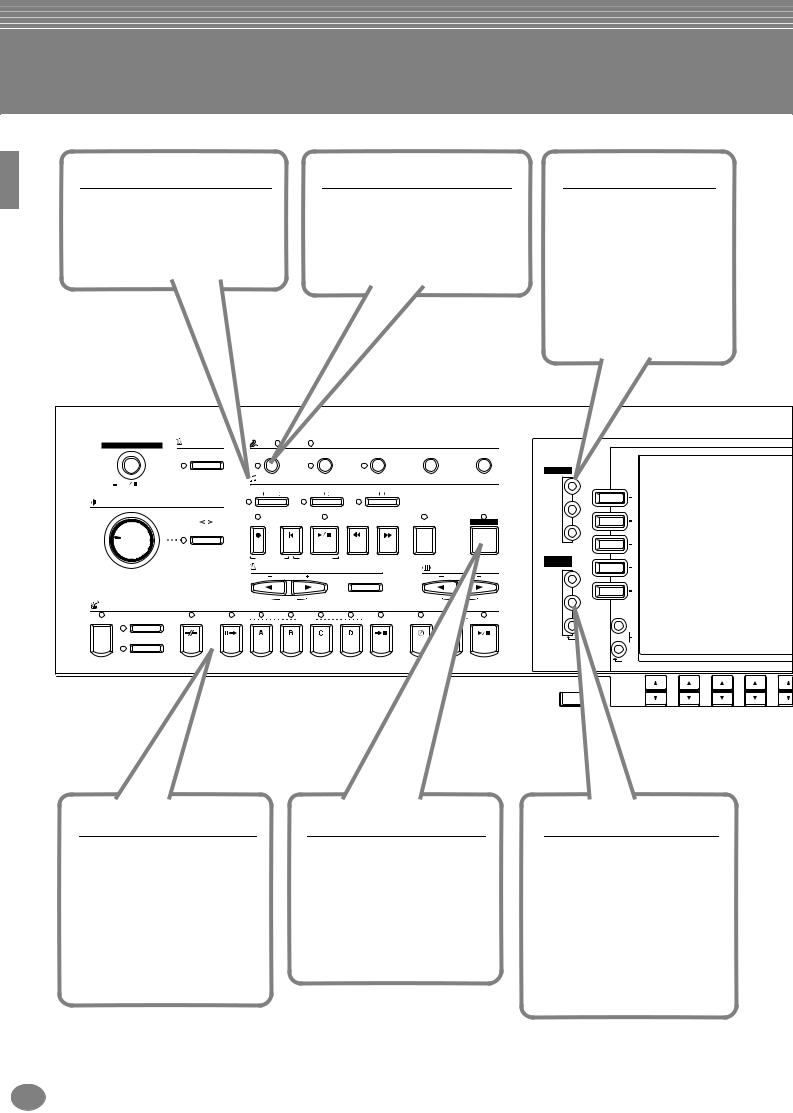
What can you do with the Clavinova?
SONG
Playback previously recorded songs (page 21, 36, 74)
Enjoy a wide variety of preset songs as well as songs on commercially available disks.
VOCAL HARMONY
Automatic backup singing (page 128)
This sophisticated function automatically adds appropriate vocal harmonies to your singing.
DEMO
Explore the Demos (page 20, 53)
These not only showcase the stunning voices and styles of the instrument, they introduce you to the various functions and features — and give you hands-on experience using the Clavinova!
POWER |
METRONOME |
MIC. |
SIGNAL |
OVER |
|
|
|
|
|
|
|||
|
|
START |
STOP |
VOCAL HARMONY |
|
TALK |
|
EFFECT |
VH TYPE SELECT |
MIC. SETTING |
|
|
|
|
|
|
|
|
|
|
|
|
|
|
|
MENU |
|
ON |
OFF |
|
|
SONG |
|
|
|
|
|
|
|
DEMO |
|
|
|
EXTRA TRACKS |
|
TRACK 2 |
|
TRACK 1 |
|
|
|
||||
|
|
|
|
|
|
|
|
|
|
||||
|
|
|
|
STYLE |
|
|
L |
|
R |
|
|
|
A |
MASTER VOLUME |
|
|
|
|
|
|
|
|
|
|
|
||
|
|
|
|
|
|
|
|
|
|
HELP |
|
||
|
|
|
|
|
|
|
|
|
|
|
|
|
|
|
|
FADE IN |
OUT |
REC |
TOP |
|
START STOP |
REW |
FF |
REPEAT |
GUIDE |
|
B |
|
|
|
|
|
|
|
|
|
|
FUNCTION |
|
||
|
|
|
|
|
|
|
|
|
|
|
|
|
|
|
|
|
|
|
|
|
|
|
|
|
|
|
C |
|
|
|
|
NEW SONG |
SYNC. START |
|
|
|
|
DIGITAL |
|
||
MIN |
MAX |
|
|
TEMPO |
|
|
|
|
|
TRANSPOSE |
STUDIO |
D |
|
|
|
|
|
|
|
|
|
|
|
||||
|
|
|
|
|
|
|
|
TAP TEMPO |
|
|
SOUND |
|
|
|
|
|
|
|
|
|
|
|
|
CREATOR |
|
||
|
|
|
|
|
|
|
|
|
|
|
|
|
|
|
|
|
|
|
|
|
|
|
|
|
|
|
E |
|
|
|
|
|
RESET |
|
|
|
|
RESET |
DIGITAL |
|
|
STYLE |
|
|
|
|
|
|
|
|
|
|
|
RECORDING |
|
ACMP |
AUTO FILL IN |
BREAK |
INTRO |
|
|
MAIN |
|
ENDING rit. |
SYNC.STOP SYNC.START START STOP |
MIXING |
BALANCE |
||
|
|
|
|
|
|
|
|
|
|
|
|
||
|
|
|
|
|
|
|
|
|
|
|
|
CONSOLE |
|
|
|
|
|
|
|
|
|
|
|
|
|
|
|
OTS LINK
PART
CHANNEL
ON OFF
PART
DIRECT ACCESS |
1 |
2 |
3 |
4 |
5 |
STYLE
Back up your performance with Auto Accompaniment (page 28, 60)
Playing a chord with your left hand automatically plays the auto accompaniment backing. Select an accompaniment style — such as pop, jazz, Latin, etc. — and let the Clavinova be your backing band!
GUIDE
Learn and practice with the Guide functions (page 38, 79)
Play back the preset songs or the appropriate disk software, and let the display and guide lamps show you when and where to play the proper notes. It’s never been easier or more fun to learn new music!
DIGITAL RECORDING
Record your performances (page 94, 110)
With the powerful and easy-to- use song recording features, you can record your own keyboard performances, and create your own complete, fully orchestrated compositions — which you can then save to the USER drive or a floppy disk for future recall.
14 CVP-209/207
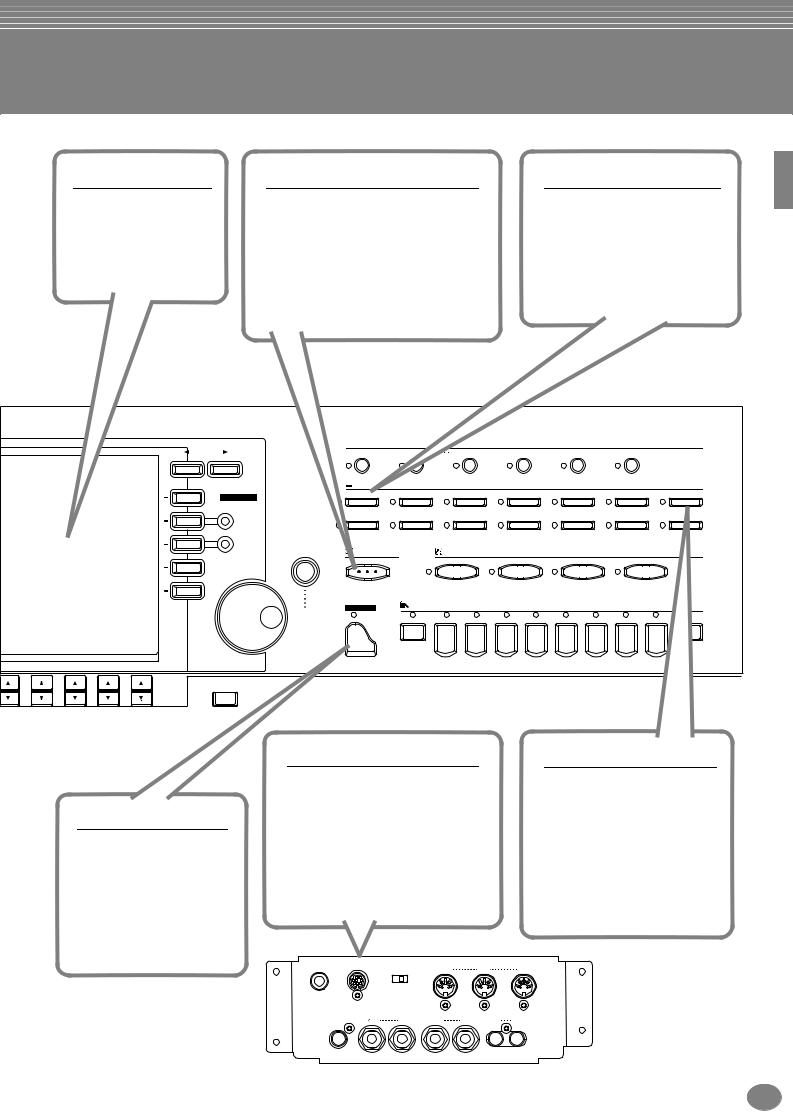
LCD |
MUSIC FINDER |
VOICE |
The large LCD (together with the various panel buttons) provides comprehensive and easy- to-understand control of the Clavinova’s operations.
Call up the perfect accompaniment |
Enjoy a huge variety of |
style (page 33, 70) |
realistic voices (page 25, 55) |
If you know what song you want to play, |
The Clavinova features a wealth of |
but you don’t know which style or voice |
exceptionally authentic and |
would be right for it, let the Music Finder |
dynamic voices (more than 800) |
help you. Just select the song title, and |
— including piano, strings, |
the Clavinova automatically calls up the |
woodwinds, and more! |
most appropriate style and voice. |
|

 VOICE EFFECT
VOICE EFFECT
|
REVERB |
DSP |
VARIATION |
HARMONY ECHO |
MONO |
LEFT HOLD |
BACK |
NEXT |
|
|
|
|
|
 VOICE
VOICE
F |
VOICE PART |
PIANO & HARPSI. |
E. PIANO |
ORGAN & ACCORDION |
PERCUSSION |
|
GUITAR |
BASS |
|
ORGAN FLUTES |
||
|
|
|
|
|
|
|
|
|
|
|
||
|
ON OFF |
|
|
|
|
|
|
|
|
|
|
|
G |
LAYER |
BRASS |
WOODWIND |
|
STRINGS |
CHOIR & PAD |
|
SYNTH. |
XG |
|
USER |
|
|
|
|
|
|
|
|
|
|
|
|
||
H |
LEFT |
|
|
|
|
|
|
|
|
|
|
|
|
ENTER |
MUSIC FINDER |
|
ONE TOCTH SETTING |
|
|
|
|
|
|
||
I |
|
|
|
|
1 |
|
2 |
|
3 |
|
4 |
|
|
|
|
|
|
|
|
|
|
||||
J |
|
|
|
|
|
|
|
|
|
|
|
|
|
|
PIANO |
REGISTRATION MEMORY |
|
|
|
|
|
|
|
||
|
DATA |
|
|
|
|
|
|
|
|
|
|
|
|
|
|
1 |
2 |
3 |
4 |
5 |
6 |
7 |
8 |
|
|
|
ENTRY |
|
FREEZE |
MEMORY |
||||||||
4 |
5 |
6 |
7 |
8 |
EXIT |
PIANO
Set up the piano — instantly (page 56)
You can call up all the optimum piano settings for the Clavinova with just a single button press — then play the extraordinarily realistic grand piano voice.
TO HOST terminal
Make music with a computer — quickly and easily (page 154)
Dive in and take advantage of the wide world of computer music software. Connections and setup are exceptionally easy, and you can play back your computer recorded parts with different instrument sounds — all from a single Clavinova!
Organ Flutes
Craft your own organ voices (page 93)
This special function not only gives you a full set of rich and luscious organ sounds, it also lets you create your own original organ voices, just as on a traditional organ, by increasing and decreasing the flute footages, and adding percussive sounds.
AUX PEDAL |
TO HOST |
HOST SELECT |
MIDI |
|
|
|
THRU |
OUT |
IN |
Mac 
 MIDI
MIDI
PC-1 PC-2
|
|
|
|
(LEVEL FIXED) |
|
L L+R |
R |
L L+R |
R |
L |
R |
VIDEO OUT AUX IN AUX OUT
CVP-209/207 15
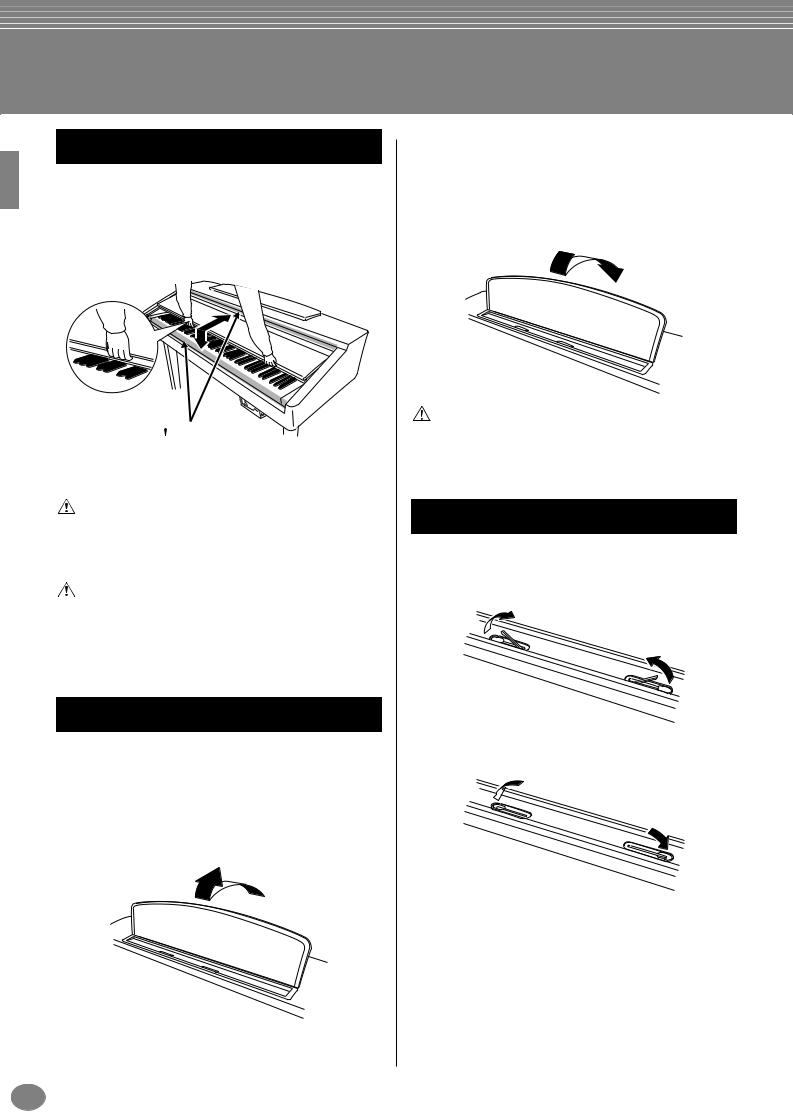
Setting Up the Clavinova
Key cover
■To open the key cover:
Lift the cover slightly, then push and slide it open.
■To close the key cover:
Slide the cover toward you and gently lower the cover over the keys.
 CAUTION
CAUTION
Be careful to avoid catching your fingers when opening or closing the cover.
CAUTION
Hold the cover with both hands when opening or closing it. Do not release it until it is fully opened or closed. Be careful to avoid catching fingers (yours or others, especially children’s) between the cover and the unit.
CAUTION
Do not place objects such as a piece of metal or paper on top of the key cover. Small objects placed on the key cover may fall inside the unit when the cover is opened and may be nearly impossible to remove. This could cause electric shock, short circuit, fire or other serious damage to the instrument.
Music Stand
■ To raise the music stand:
1 Pullgo. the music stand toward yourself as far as it will
2 Lower the music stand until it locks in place.
■ To lower the music stand:
1 Pullgo. the music stand toward yourself as far as it will
2 Gently lower the music stand backward until it is all the way down.
CAUTION
Do not try to use the music stand in a half-raised position. Also, when lowering the stand, let the stand all the way down before releasing it.
Sheet Music Braces
These braces are for holding the pages of music books in place.
■ To open
■ To close
16 CVP-209/207
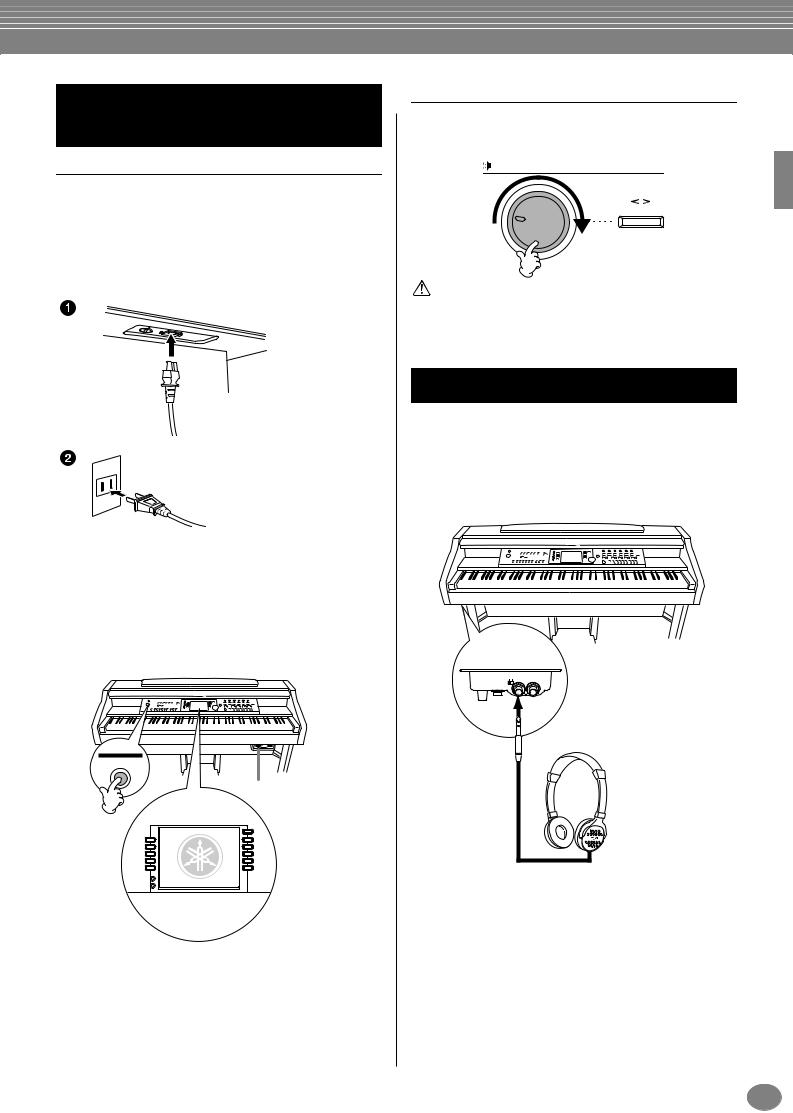
Turning the Power On
and Off
Connect the power cord.
1 Insert the plugs at the ends of the cord, one into the AC INLET on the Clavinova, and the other into a standard AC outlet.
In some areas, a plug adapter may be provided to match the pin configuration of the AC wall outlets in your area.
(The shape of plug differs depending on locale.)
2 Press the [POWER] switch.
→The main display appears in the LCD display. The drive lamp below the lower right end of the keyboard also lights.
POWER
 ON
ON  OFF
OFF
The drive lamp lights.
BACK
A
B
C
D
E
BALANCE
CHANNEL
ON OFF
PART
When you’re ready to turn off the power, press the [POWER] switch again.
→Both the display and the drive lamp below the right end of the keyboard will turn off.
Setting the volume
Use the [MASTER VOLUME] dial to adjust the volume to an appropriate level.
MASTER VOLUME
FADE IN / OUT
MIN |
MAX |
CAUTION
Do not use the Clavinova at a high volume level for a long period of time, or your hearing may be damaged.
Using headphones
Connect a pair of headphones to one of the [PHONES] jacks.
Two [PHONES] jacks are provided.
Two sets of standard stereo headphones can be plugged in. (If you are using only one pair of headphones, you can plug them into either of these jacks.)
INPUT |
MIC. |
MIC. LINE PHONES |
VOLUME |
LINE IN |
|
MIN MAX |
|
|
CVP-209/207
17
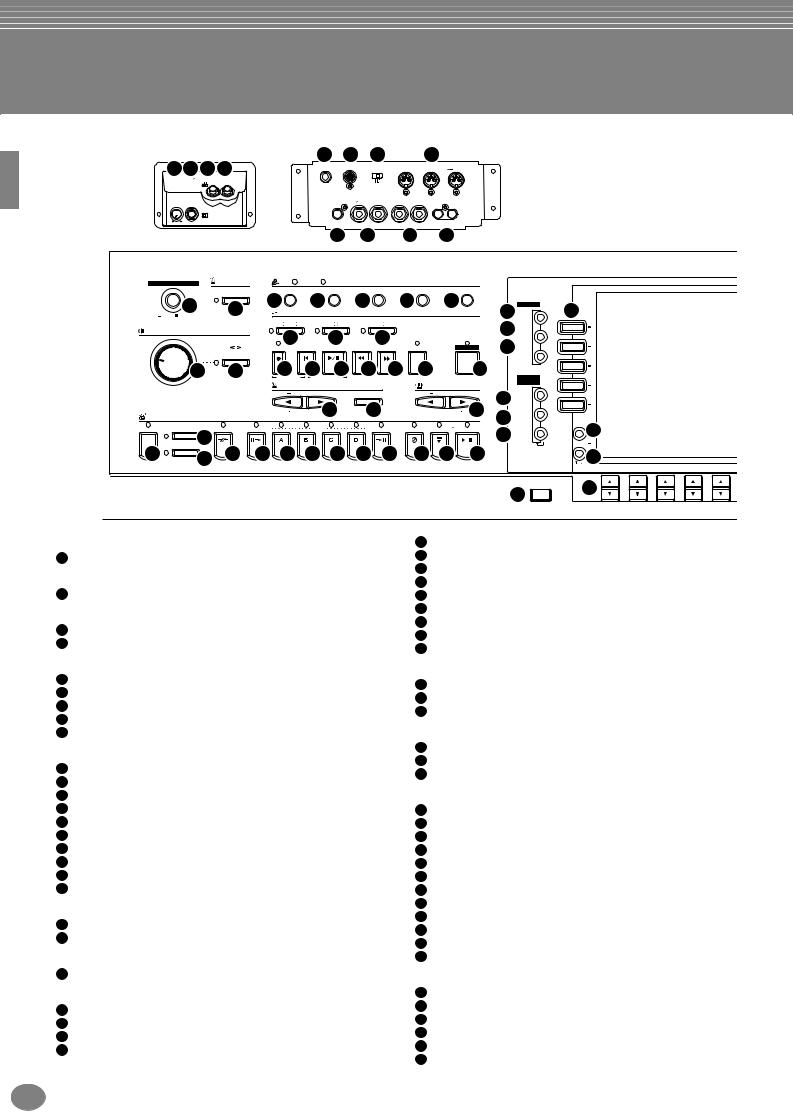
Panel Controls and Terminals
69 70 71 72 |
|
|
|
76 |
75 |
74 |
|
|
73 |
|
|
|
|
|
|
|
|
|
|
|||||
|
|
AUX PEDAL |
TO HOST |
HOST SELECT |
|
|
MIDI |
|
|
|
|
|
|
|
|
|
|
|||||||
|
|
|
|
|
|
|
|
|
|
|
|
THRU |
OUT |
IN |
|
|
|
|
|
|
|
|
|
|
|
INPUT |
MIC. |
MIC. LINE |
PHONES |
|
|
|
|
|
Mac |
MIDI |
|
|
|
|
|
|
|
|
|
|
|
|
|
|
VOLUME |
LINE IN |
|
|
|
|
|
|
|
PC-1 |
PC-2 |
|
|
|
|
|
|
|
|
|
|
|
|
|
|
MIN MAX |
|
|
|
|
|
|
|
|
|
|
|
|
|
|
|
|
|
|
|
|
|
|
|
|
|
|
|
|
|
|
|
|
|
|
|
|
|
(LEVEL FIXED) |
|
|
|
|
|
|
|
|
|
|
|
|
|
|
|
|
|
|
|
L L+R |
R |
L L+R |
R |
L |
R |
|
|
|
|
|
|
|
|
|
|
|
|
|
|
|
|
|
|
VIDEO OUT |
AUX IN |
|
|
|
AUX OUT |
|
|
|
|
|
|
|
|
|
|
|
|
|
|
|
|
|
|
|
77 |
78 |
|
|
79 |
|
80 |
|
|
|
|
|
|
|
|
|
|
POWER |
|
|
METRONOME |
MIC. |
SIGNAL |
OVER |
|
|
|
|
|
|
|
|
|
|
|
|
|
|
|
|
||
|
|
|
|
|
|
|
|
|
|
|
|
|
|
|
|
|
|
|
|
|
|
|
||
|
|
|
|
START STOP |
VOCAL HARMONY |
TALK |
|
EFFECT |
|
VH TYPE SELECT MIC. SETTING |
|
|
|
|
|
|
|
|
||||||
|
|
1 |
|
2 |
|
5 |
6 |
|
7 |
|
|
8 |
|
9 |
|
|
MENU |
42 |
|
|
|
|
||
|
|
|
|
SONG |
|
|
|
|
|
|
|
|
|
|
36 DEMO |
|
|
|
|
|||||
ON |
OFF |
|
|
|
TRACK 2 |
TRACK 1 |
|
|
|
|
|
|
|
|
|
|||||||||
|
|
|
|
|
|
EXTRA TRACKS |
|
|
|
|
|
37 |
|
|
|
|
|
|
||||||
|
|
|
|
|
|
STYLE |
|
L |
|
|
R |
|
|
|
|
|
A |
|
|
|
|
|
||
MASTER VOLUME |
|
|
|
|
|
|
|
|
|
|
|
|
|
|
|
|
|
|
|
|||||
|
|
|
10 |
|
11 |
|
|
12 |
|
|
|
|
|
|
|
|
|
|
|
|||||
|
|
|
|
|
|
|
|
|
|
|
|
|
|
|
HELP |
|
|
|
|
|
|
|||
|
|
|
|
FADE IN |
OUT |
REC |
TOP |
START STOP REW |
FF |
|
REPEAT |
|
GUIDE |
38 |
B |
|
|
|
|
|
||||
|
|
|
|
|
|
|
|
|
|
|
|
|
|
|
|
|
|
|
|
|
||||
|
|
|
|
|
|
13 |
14 |
15 |
16 |
17 |
18 |
|
19 |
|
FUNCTION |
|
|
|
|
|
|
|||
|
|
3 |
4 |
|
|
|
|
C |
|
|
|
|
|
|||||||||||
|
|
|
NEW SONG |
SYNC. START |
|
|
|
|
|
|
|
|
|
DIGITAL |
|
|
|
|
|
|
||||
MIN |
|
MAX |
|
|
|
TEMPO |
|
|
|
|
|
|
|
TRANSPOSE |
|
|
STUDIO |
D |
|
|
|
|
|
|
|
|
|
|
|
|
|
|
|
|
|
|
|
|
|
|
|
|
|
|
|
||||
|
|
|
|
|
|
|
|
|
TAP TEMPO |
|
|
|
|
|
|
SOUND |
|
|
|
|
|
|
||
|
|
|
|
|
|
|
|
|
|
|
|
|
|
39CREATOR |
|
|
|
|
|
|
||||
|
|
|
|
|
|
|
|
20 |
|
21 |
|
|
|
|
22 |
E |
|
|
|
|
|
|||
|
|
|
|
|
|
RESET |
|
|
|
|
RESET |
40 |
DIGITAL |
|
|
|
|
|
|
|||||
STYLE |
|
|
|
|
|
|
|
|
|
|
|
|
|
|
|
|
RECORDING |
|
|
|
|
|
|
|
ACMP |
AUTO FILL IN |
BREAK |
INTRO |
|
MAIN |
|
ENDING rit. |
SYNC.STOP SYNC.START START STOP |
|
MIXING |
|
43 |
|
|
|
|
||||||||
|
|
|
24 |
|
|
|
|
|
|
|
|
|
|
|
|
|
|
|
|
|
|
|
||
|
OTS LINK |
|
|
|
|
|
|
|
|
|
|
|
|
|
41CONSOLE |
BALANCE |
|
|
|
|
||||
23 |
|
26 |
27 |
28 |
29 |
30 |
31 |
32 |
33 |
34 |
35 |
|
PART |
|
|
|
|
|
|
|||||
|
|
25 |
|
CHANNEL |
44 |
|
|
|
|
|||||||||||||||
|
|
|
|
|
|
|
|
|||||||||||||||||
|
|
|
|
|
|
|
|
|
|
|
|
|
|
|
|
|
|
|
ON OFF |
|
|
|
|
|
|
|
|
|
|
|
|
|
|
|
|
|
|
|
|
|
|
|
|
|
PART |
|
|
|
|
|
|
|
|
|
|
|
|
|
|
|
|
|
|
|
|
|
|
45 |
|
50 |
|
|
|
|
|
|
|
|
|
|
|
|
|
|
|
|
|
|
|
|
|
|
|
|
|
|
|
|
|
|
|
|
|
|
|
|
|
|
|
|
|
|
|
|
|
|
|
DIRECT ACCESS |
1 |
2 |
3 |
4 |
5 |
|
POWER
1 [ON / OFF] button (POWER)................................................ |
P. 17 |
METRONOME
2 [START / STOP] button (METRONOME) ............................. |
P. 51 |
MASTER VOLUME
3 |
[MASTER VOLUME] dial...................................................... |
P. 17 |
4 |
[FADE IN / OUT] button........................................................ |
P. 66 |
MIC.
5 |
[VOCAL HARMONY] button............................................... |
P. 128 |
6 |
[TALK] button ..................................................................... |
P. 128 |
7 |
[EFFECT] button ................................................................ |
P. 128 |
8 |
[VH TYPE SELECT] button................................................ |
P. 128 |
9 |
[MIC. SETTING] button ...................................................... |
P. 128 |
SONG
10 |
[EXTRA TRACKS (STYLE)] button ...................................... |
P. 78 |
11 |
[TRACK 2 (L)] button............................................................ |
P. 78 |
12 |
[TRACK 1 (R)] button ........................................................... |
P. 78 |
13 |
[REC] button ........................................................................ |
P. 94 |
14 |
[TOP] button......................................................................... |
P. 77 |
15 |
[START / STOP] button (SONG) .......................................... |
P. 75 |
16 |
[REW] button........................................................................ |
P. 77 |
17 |
[FF] button............................................................................ |
P. 77 |
18 |
[REPEAT] button .................................................................. |
P. 78 |
19 |
[GUIDE] button..................................................................... |
P. 79 |
TEMPO
20 |
[E] [F] buttons (TEMPO)............................................... |
P. 51 |
21 |
[TAP TEMPO] button ............................................................ |
P. 52 |
TRANSPOSE
22 [E] [F] buttons (TRANSPOSE) ................................... |
P. 141 |
STYLE
23 |
[ACMP] button...................................................................... |
P. 61 |
24 |
[AUTO FILLIN] button........................................................... |
P. 67 |
25 |
[OTS LINK] button................................................................ |
P. 69 |
26 |
[BREAK] button.................................................................... |
P. 65 |
27 |
[INTRO] button............................................................... |
P. 31, 67 |
28 |
MAIN [A] button.................................................................... |
P. 65 |
29 |
MAIN [B] button.................................................................... |
P. 65 |
30 |
MAIN [C] button ................................................................... |
P. 65 |
31 |
MAIN [D] button ................................................................... |
P. 65 |
32 |
[ENDING / rit.] button..................................................... |
P. 31, 67 |
33 |
[SYNC.STOP] button ........................................................... |
P. 66 |
34 |
[SYNC.START] button.......................................................... |
P. 61 |
35 |
[START / STOP] button (STYLE) ......................................... |
P. 61 |
MENU
36 |
[DEMO] button ..................................................................... |
P. 53 |
37 |
[HELP] button ...................................................................... |
P. 50 |
38 |
[FUNCTION] button ........................................................... |
P. 133 |
DIGITAL STUDIO
39 |
[SOUND CREATOR] button ................................................. |
P. 88 |
40 |
[DIGITAL RECORDING] button ................................... |
P. 94, 110 |
41 |
[MIXING CONSOLE] button............................................... |
P. 120 |
DISPLAY CONTROL
42 |
[A] - [J] buttons..................................................................... |
P. 41 |
43 |
[BALANCE] button ............................................................... |
P. 62 |
44 |
[CHANNEL ON / OFF] button ........................................ |
P. 62, 77 |
45 |
[DIRECT ACCESS] button................................................... |
P. 48 |
46 |
[BACK] button ................................................................ |
P. 41, 47 |
47 |
[NEXT] button ................................................................ |
P. 41, 47 |
48 |
VOICE PART ON / OFF [LAYER] button.............................. |
P. 57 |
49 |
VOICE PART ON / OFF [LEFT] button ................................ |
P. 57 |
50 |
[1▲▼] - [8▲▼] buttons ................................................. |
P. 39 - 46 |
51 |
[ENTER] button.................................................................... |
P. 47 |
52 |
[DATA ENTRY] dial............................................................... |
P. 47 |
53 |
[EXIT] button ........................................................................ |
P. 41 |
VOICE EFFECT
54 |
[REVERB] button ................................................................. |
P. 58 |
55 |
[DSP] button......................................................................... |
P. 58 |
56 |
[VARIATION] button ............................................................. |
P. 58 |
57 |
[HARMONY / ECHO] button ................................................ |
P. 59 |
58 |
[MONO] button..................................................................... |
P. 59 |
59 |
[LEFT HOLD] button ............................................................ |
P. 59 |
18 CVP-209/207
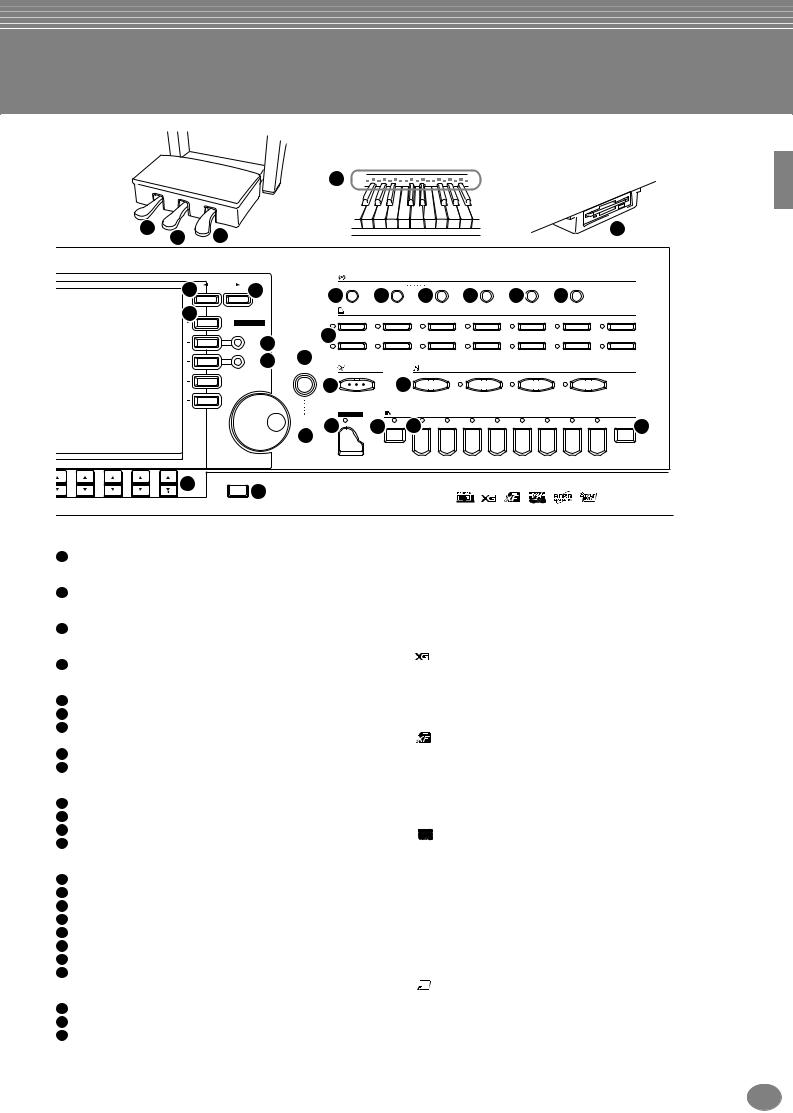
|
|
|
|
|
|
|
|
|
68 |
|
|
|
|
|
|
|
|
|
|
|
|
|
|
|
81 |
82 |
83 |
|
|
|
|
|
|
|
|
|
|
|
|
|
|
|
67 |
|
|
|
|
|
|
|
|
|
|
|
|
|
|
|
|
|
|
|
|
||
|
|
|
|
|
|
|
|
|
|
VOICE EFFECT |
|
|
|
|
|
|
|
|
|
|
|
|
|
|
|
46 BACK |
|
NEXT |
47 |
|
|
REVERB |
DSP |
|
VARIATION |
|
HARMONY ECHO |
|
MONO |
LEFT HOLD |
|
|
|
|
|
|
|
|
|
54 |
55 |
56 |
57 |
|
58 |
|
59 |
|
|
||||||
|
|
|
|
|
|
|
|
|
|
|
|
|
|||||||||
|
|
|
|
42 |
|
|
|
|
|
VOICE |
|
|
|
|
|
|
|
|
|
|
|
|
|
|
|
F |
VOICE PART |
|
PIANO & HARPSI. |
E. PIANO |
ORGAN & ACCORDION |
PERCUSSION |
|
GUITAR |
BASS |
|
ORGAN FLUTES |
||||||
|
|
|
|
|
|
|
|
|
|
|
|
|
|
|
|
|
|
|
|||
|
|
|
|
|
|
ON OFF |
|
60 |
|
|
|
|
|
|
|
|
|
|
|
|
|
|
|
|
|
|
G |
|
LAYER 48 |
|
BRASS |
WOODWIND |
|
STRINGS |
|
CHOIR & PAD |
|
SYNTH. |
XG |
|
USER |
||
|
|
|
|
|
|
51 |
|
|
|
|
|
|
|
|
|
|
|
|
|
||
|
|
|
|
|
H |
|
LEFT 49 |
|
|
|
|
|
|
|
|
|
|
|
|
|
|
|
|
|
|
|
|
|
|
ENTER |
|
MUSIC FINDER |
|
ONE TOCTH SETTING |
|
|
|
|
|
|
|||
|
|
|
|
|
I |
|
|
|
61 |
|
62 |
|
1 |
|
|
2 |
|
3 |
4 |
|
|
|
|
|
|
|
|
|
|
|
|
|
|
|
|
|
|
||||||
|
|
|
|
|
|
|
|
|
|
|
|
|
|
|
|
|
|
|
|
||
|
|
|
|
|
J |
|
|
|
|
|
|
|
|
|
|
|
|
|
|
|
|
|
|
|
|
|
|
|
|
DATA |
|
PIANO |
REGISTRATION MEMORY |
|
|
|
|
|
|
|
|
||
|
|
|
|
|
|
|
|
63 |
64 FREEZE 651 |
|
|
|
|
|
|
|
|
MEMORY 66 |
|||
|
|
|
|
|
|
|
|
ENTRY |
2 |
|
3 |
4 |
5 |
6 |
7 |
8 |
|||||
|
|
|
|
|
|
|
|
52 |
|
|
|
|
|
|
|
|
|
|
|
|
|
|
|
|
|
50 |
|
|
53 |
|
|
|
|
|
|
|
|
|
|
|
|
|
|
|
|
|
|
|
|
|
|
|
|
|
|
|
|
|
|
|
|
|
|
|
|
4 |
5 |
6 |
7 |
8 |
|
EXIT |
|
|
|
|
|
|
|
|
|
|
|
|
|
|
|
VOICE
60 VOICE buttons ..................................................................... |
P. 55 |
MUSIC FINDER
61 [MUSIC FINDER] button ...................................................... |
P. 70 |
ONE TOUCH SETTING
62 [1] - [4] buttons (ONE TOUCH SETTING)............................ |
P. 68 |
PIANO Setting
63 [PIANO] button ..................................................................... |
P. 56 |
REGISTRATION MEMORY
64 |
[FREEZE] button .................................................................. |
P. 87 |
65 |
[1] – [8] buttons (REGISTRATION MEMORY) ..................... |
P. 85 |
66 |
[MEMORY] button ................................................................ |
P. 85 |
67 |
Floppy disk drive (3.5”)........................................................... |
P. 6 |
68 |
Keyboard guide lamps ......................................................... |
P. 79 |
Microphone and Headphone Connectors |
|
|
69 |
[INPUT VOLUME] knob...................................................... |
P. 152 |
70 |
[MIC. LINE IN] jack............................................................. |
P. 152 |
71 |
[MIC. LINE] switch.............................................................. |
P. 152 |
72 |
[PHONES] jacks................................................................. |
P. 152 |
Connectors |
|
|
73 |
MIDI [THRU] [OUT] [IN] terminals...................................... |
P. 154 |
74 |
[HOST SELECT] switch ..................................................... |
P. 154 |
75 |
[TO HOST] terminal ........................................................... |
P. 155 |
76 |
[AUX PEDAL] jack.............................................................. |
P. 154 |
77 |
[VIDEO OUT] jack .............................................................. |
P. 153 |
78 |
AUX IN [L / L+R] [R] jacks.................................................. |
P. 153 |
79 |
AUX OUT [L / L+R] [R] jacks.............................................. |
P. 153 |
80 |
AUX OUT (LEVEL FIXED) [L] [R] jacks ............................. |
P. 153 |
Pedals |
|
|
81 |
Left pedal ............................................................................. |
P. 59 |
82 |
Sostenuto pedal ................................................................... |
P. 59 |
83 |
Damper pedal ...................................................................... |
P. 59 |
The Panel Logos
The logos printed on the Clavinova panel indicate standards/formats it supports and special features it includes.

 GM System Level 1
GM System Level 1
“GM System Level 1” is an addition to the MIDI standard which guarantees that any data conforming to the standard will play accurately on any GM-compatible tone generator or synthesizer from any manufacturer.
XG Format
XG is a new Yamaha MIDI specification which significantly expands and improves on the “GM System Level 1” standard with greater voice handling capacity, expressive control, and effect capability while retaining full compatibility with GM. By using the Clavinova’s XG voices, it is possible to record XG-compatible song files.
XF Format
The Yamaha XF format enhances the SMF (Standard MIDI File) standard with greater functionality and open-ended expandability for the future. The Clavinova is capable of displaying lyrics when an XF file containing lyric data is played. (SMF is the most common format used for MIDI sequence files. The Clavinova is compatible with SMF Formats 0 and 1, and records “song” data using SMF Format 0.)
Vocal Harmony
Vocal Harmony employs state-of-the-art digital signal processing technology to automatically add appropriate vocal harmony to a lead vocal line sung by the user. Vocal Harmony can even change the character and gender of the lead voice as well as the added voices to produce a wide range of vocal harmony effects.
 Disk Orchestra Collection
Disk Orchestra Collection
The DOC voice allocation format provides data playback compatibility with a wide range of Yamaha instruments and MIDI devices.
 Style File Format
Style File Format
The Style File Format (SFF) is Yamaha’s original style file format, which uses a unique conversion system to provide high-quality automatic accompaniment based on a wide range of chord types. The Clavinova uses the SFF internally, reads optional SFF style disks, and creates SFF styles using the Style Creator feature.
CVP-209/207 19
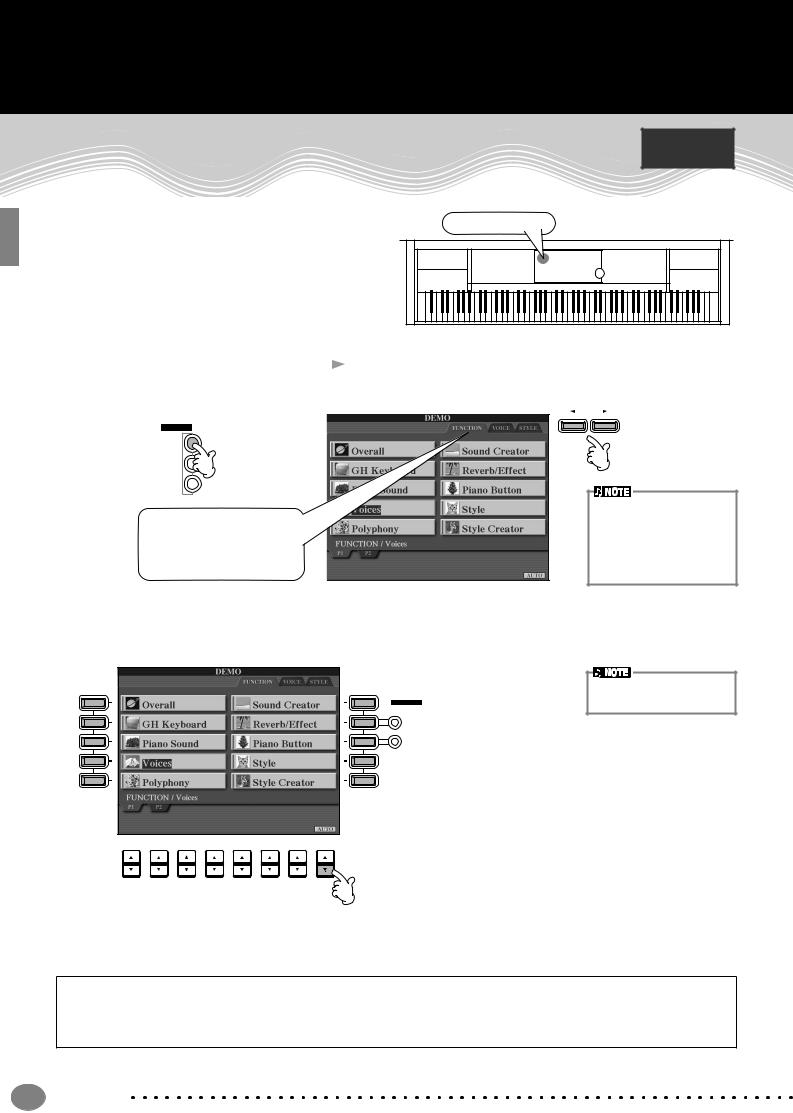
Quick Guide . . . . . . . . . . . . . . . . . . . . . . . . .
Playing the Demos
The Clavinova features an extensive variety of Demo songs, that showcase its rich, authentic voices and its dynamic rhythms and styles.
What’s more, there’s a special selection of Demo functions. These take you through a hands-on journey of all the important features and functions of the instrument
— letting you see firsthand how to effectively use the Clavinova in your own music.
Reference on page 53
Demo button
 1 Pressing the [DEMO] button automatically plays back the Demo songs at random.
1 Pressing the [DEMO] button automatically plays back the Demo songs at random.
 2 Press the [BACK]/[NEXT] button to select the Demo categories.
2 Press the [BACK]/[NEXT] button to select the Demo categories.
MENU
DEMO
HELP
FUNCTION
For this example, FUNCTION is selected. Function Demos demonstrate many of the different functions on the CVP-209/207.
BACK NEXT
Voice Demos showcase the voices of the CVP-209/207. Style Demos introduce you to the rhythms and accompaniment styles of the CVP209/207 (page 53).
 3 Press any of the [A] to [J] buttons or [8▼] (AUTO) button (FUNCTION page only) to select the Demo songs.
3 Press any of the [A] to [J] buttons or [8▼] (AUTO) button (FUNCTION page only) to select the Demo songs.
For this example, press the [8▼] (AUTO) button.
All of the function demos are played back in sequence.
A |
F |
VOICE PART |
ON OFF
For details about the Demos, refer to page 53.
B |
G |
LAYER |
C |
H |
LEFT |
D |
I |
|
E |
J |
|
1 |
2 |
3 |
4 |
5 |
6 |
7 |
8 |
Press the [EXIT] button to exit from the demo mode and return to the MAIN display when you’ve finished playing the demo songs.
When you’re done with the Demos, you can get to know your Clavinova even better with these functions:
•Preset Song (Song Book) playback (page 21)
•Disk Song Playback (page 21)
•Short demo playback of the selected voice (in the Voice Open display; page 26).
20 Quick Guide
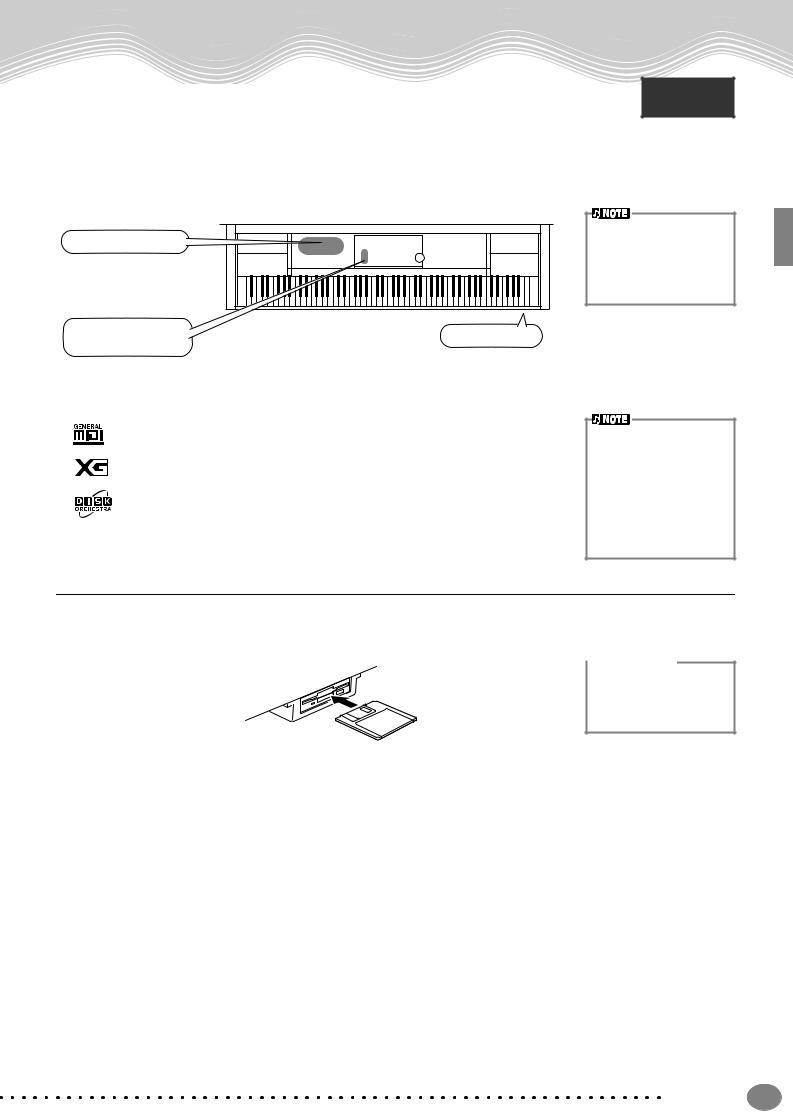
|
Song Playback |
Song Playback |
Reference |
|
on page 74 |
Here’s where all of the amazing voices, effects, rhythms, styles and other sophisticated features of the Clavinova come together — in songs!
As you heard in the Demos, the Clavinova contains many built-in recordings. But there’s more. Call up the Song Open (PRESET) display. And there’s an even greater wealth of song material you can enjoy with your Clavinova — in commercially available software.
Song related buttons
BALANCE and CHANNEL buttons
Floppy disk drive
Make sure that the Language setting for the instrument (page 151) is the same as that of the file name of the song that you are playing back.
The following songs are compatible for playback on the CVP-209/207. Refer to pages 74, 159 for more details on the logos.
Disks bearing this logo contain song data for voices defined in the GM standard.
Disks bearing this logo contain song data using the XG format, an extension of the GM standard that provides a wider variety of voices and more comprehensive sonic control.
Disks bearing this logo contain song data for voices defined in Yamaha’s DOC format.
Songs containing a large amount of data may not be able to be read properly by the instrument, and as such you may not be able to select them. The maximum capacity is about 200– 300KB, however this may differ depending on the data contents of each song.
Playback of Songs
 1 If you want to play back a disk song, insert an appropriate disk containing song data into the disk drive.
1 If you want to play back a disk song, insert an appropriate disk containing song data into the disk drive.

 CAUTION
CAUTION
• Make sure to read the section “Using the Floppy Disk Drive (FDD) and Floppy Disks” on page 6.
Quick Guide |
21 |
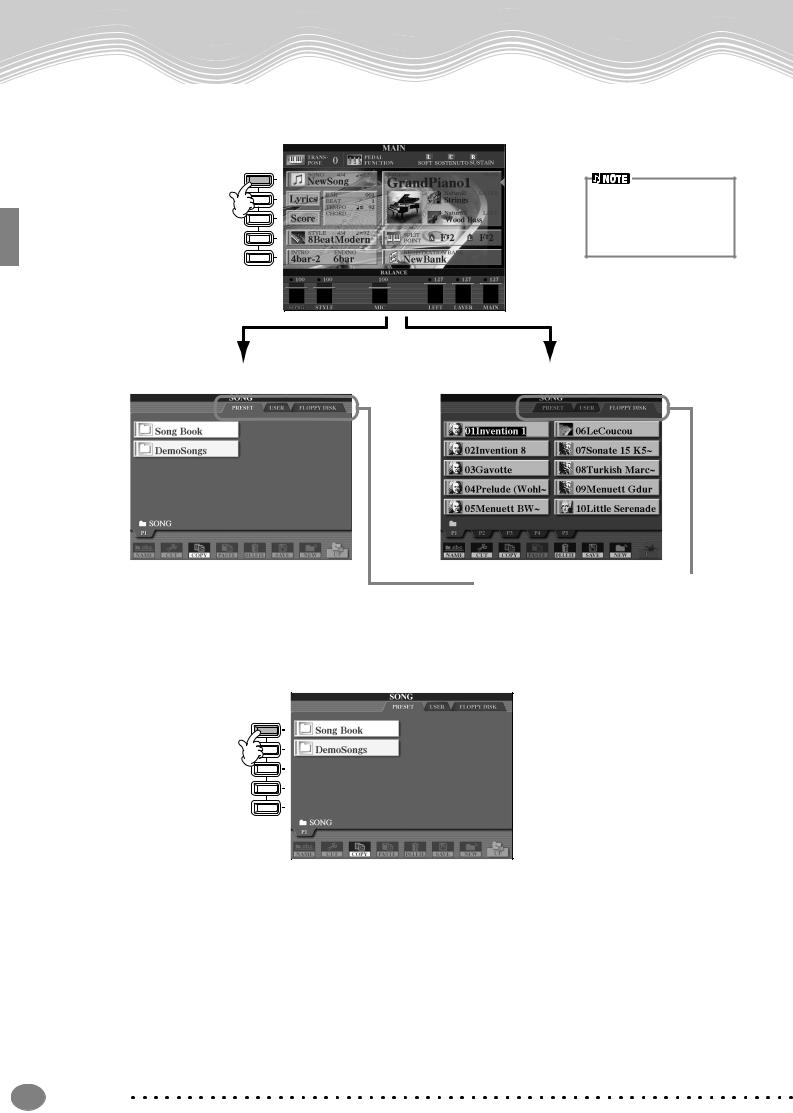
Song Playback
 2 Press the [A] button to call up the Song Open display.
2 Press the [A] button to call up the Song Open display.
If the MAIN screen is not displayed, press the [DIRECT ACCESS] button followed by the [EXIT] button.
A
B
C
D
From the MAIN display (the display shown when the power is turned on), you can select songs, voices, accompaniment styles, etc.
E
PRESET |
FLOPPY DISK |
||
|
|
|
|
|
|
|
|
Press the [BACK]/[NEXT] button to select the drive.
 3 Press the [A] button to select the preset songs (Song Book) folder.
3 Press the [A] button to select the preset songs (Song Book) folder.
A
B
C
D
E
22 Quick Guide
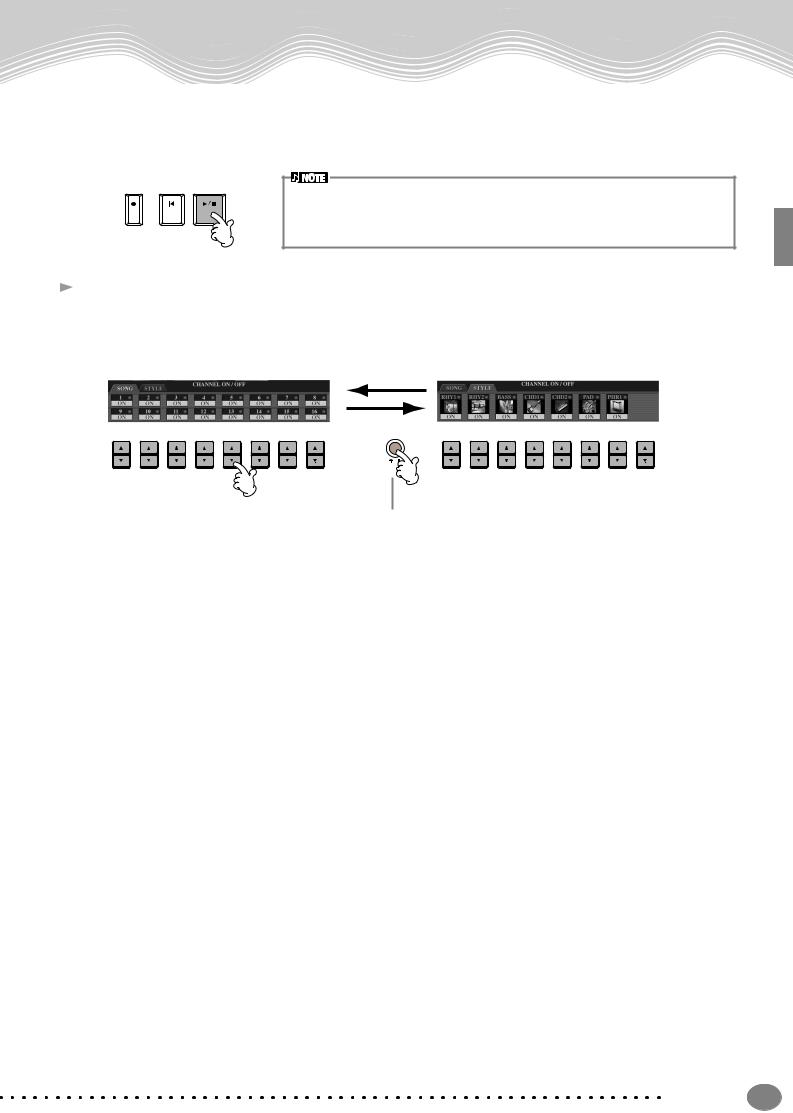
Song Playback
 4
4  5
5
Press one of the [A] to [J] buttons to select a song file.
Press the SONG [START/STOP] button to start playback.
REC |
TOP START / STOP |
 NEW SONG
NEW SONG
 SYNC.START
SYNC.START
•To rewind or fast forward to the playback point of the song, press the [REW] or [FF] button.
•With song data software (Standard MIDI format 0) that includes lyrics, you can view the lyrics on the display during playback. You can also view the score. See pages 81 and 84 for details.
 6 While the song is playing, try using the Mute function to turn certain instrument channels off or on — letting you craft dynamic arrangements on the fly!
6 While the song is playing, try using the Mute function to turn certain instrument channels off or on — letting you craft dynamic arrangements on the fly!
1)Press the [CHANNEL ON/OFF] button.
2)Press the [1 - 8▲▼] button corresponding to the channel you wish to turn on or off.
CHANNEL
ON / OFF
PART
1 |
2 |
3 |
4 |
5 |
6 |
7 |
8 |
1 |
2 |
3 |
4 |
5 |
6 |
7 |
8 |
If the STYLE tab is selected, press this button again.
Quick Guide |
23 |
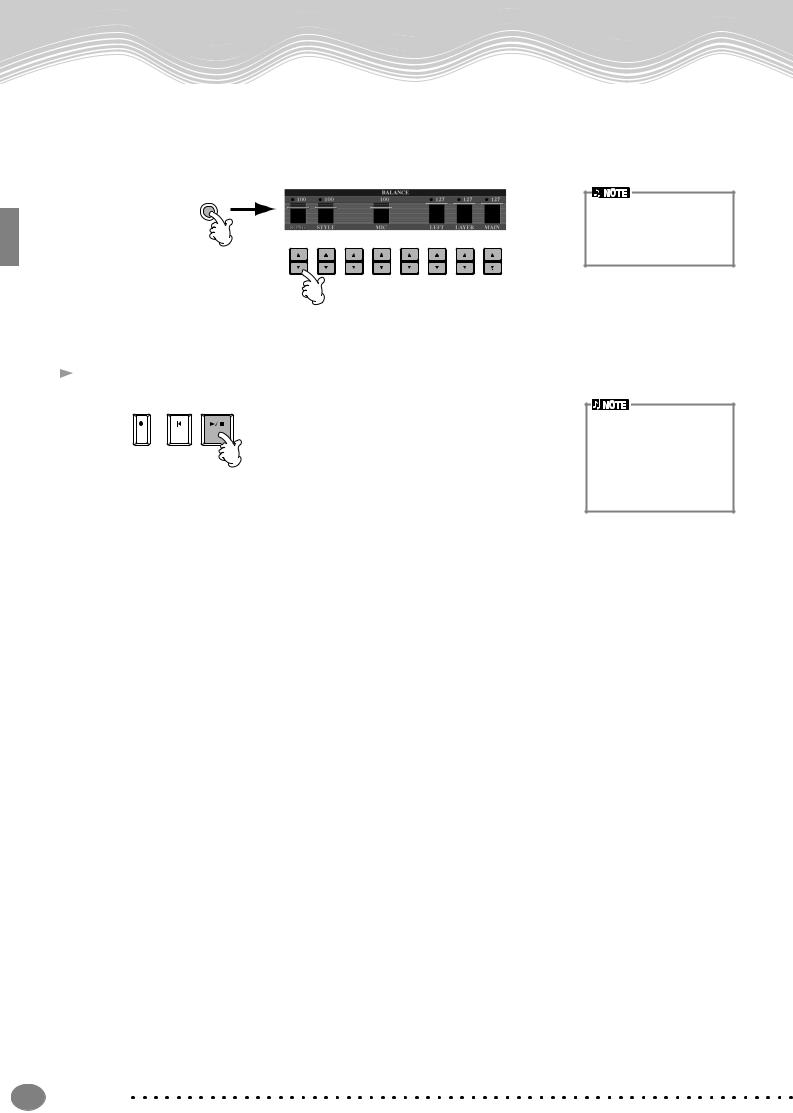
Song Playback
 7 Finally, take the producer’s seat and try your hand at mixing. These Balance controls let you adjust the levels of the individual parts — the song, the style, your singing, and your playing.
7 Finally, take the producer’s seat and try your hand at mixing. These Balance controls let you adjust the levels of the individual parts — the song, the style, your singing, and your playing.
1)Press the [BALANCE] button.
2)Press the [1 - 8▲▼] button corresponding to the part of which the volume you wish to adjust.
BALANCE
You can call up a full set of mixing controls by pressing the [MIXING CONSOLE] button (page 120).
1 |
2 |
3 |
4 |
5 |
6 |
7 |
8 |
 8 Press the SONG [START/STOP] button to stop playback.
8 Press the SONG [START/STOP] button to stop playback.
REC |
TOP START / STOP |
 NEW SONG
NEW SONG 
 SYNC.START
SYNC.START 
•The [FADE IN/OUT] button (page 66) can be used to produce smooth fadeins and fade-outs when starting and stopping the song, as well as the accompaniment.
24 Quick Guide
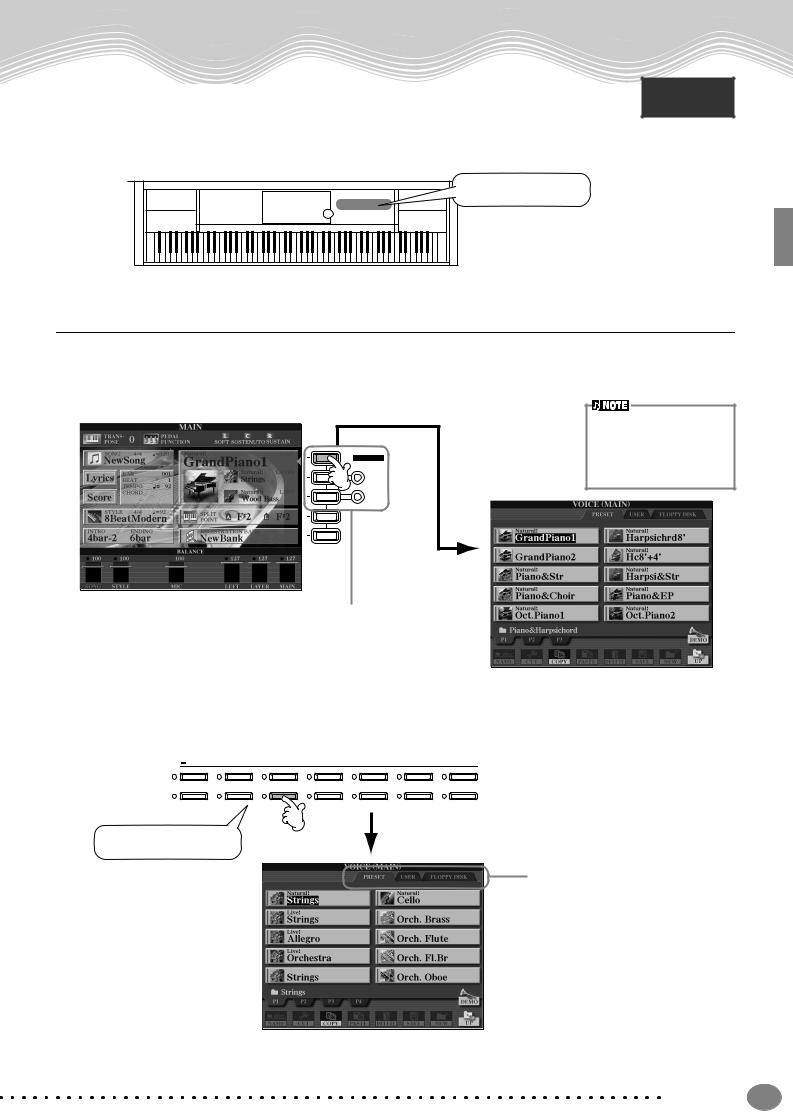
Playing Voices
The Clavinova features a stunning variety of over 800 dynamic, rich and realistic voices. Try playing some of these voices now and hear what they can do for your music. Here, you’ll learn how to
select individual voices, combine two voices in a layer, and split two voices between your left and right hands.
Voice related buttons
Playing a Voice
 1 Press the [F] button to call up the menu for selecting the MAIN voice.
1 Press the [F] button to call up the menu for selecting the MAIN voice.
If the MAIN screen is not displayed, press the [DIRECT ACCESS] button followed by the [EXIT] button.
F VOICE PART
ON OFF
G LAYER
H LEFT
I
J
You’ll want to hear the MAIN voice all by itself — so make sure that the LAYER and LEFT parts are turned off.
The voice you’re selecting here belongs to the MAIN part, and is called the MAIN voice. (See page 57 for more information.)
 2 Select a voice group.
2 Select a voice group.
 VOICE
VOICE
PIANO & HARPSI. |
E. PIANO |
ORGAN & ACCORDION |
PERCUSSION |
GUITAR |
BASS |
ORGAN FLUTES |
BRASS |
WOODWIND |
STRINGS |
CHOIR & PAD |
SYNTH. |
XG |
USER |
For this example, STRINGS is selected.
Press the [BACK]/[NEXT] button to select the memory location of the voice. For this example, PRESET is selected.
Quick Guide |
25 |
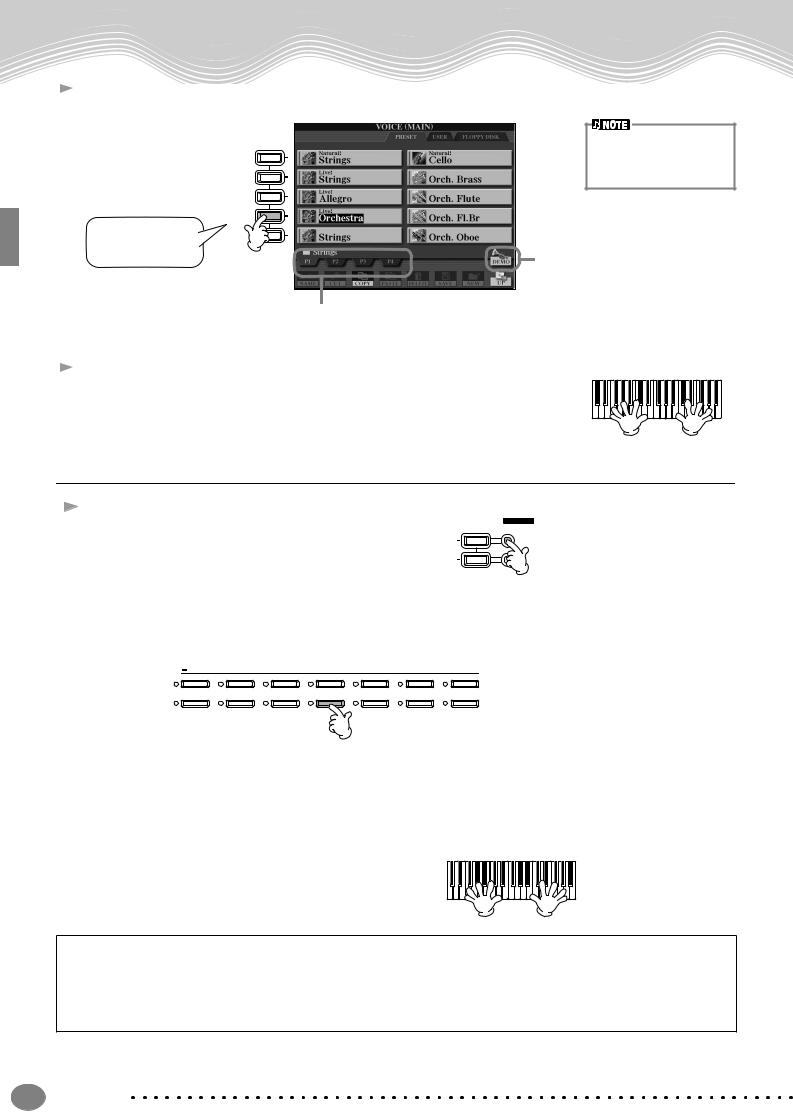
Playing Voices
 3 Select a voice.
3 Select a voice.
For this example, ”Orchestra” is selected.
A
B
C
D
E
Press the corresponding buttons to select the other pages — and discover even more voices.
You can instantly jump back to the Main display by “dou- ble-clicking” on one of the [A] - [J] buttons.
Press the [8▲] button to start the Demo for the selected voice. To stop the Demo, press this button again. There’s more to the Demo features than just voices, though–for more information, see page 53.
 4 Play the voices.
4 Play the voices.
Naturally, you can play the voice yourself from the keyboard, but you can also have the Clavinova demonstrate the voice for you. Simply press the [8▲] button from the display above, and a Demo of the voice plays automatically.
Playing Two Voices Simultaneously
1 Press the VOICE PART ON/OFF [LAYER] button to |
VOICE PART |
turn the LAYER part on. |
ON OFF |
|
 2
2  3
3
G LAYER
H LEFT
Press the [G] button to select the LAYER part.
Select a voice group.
Here, we’ll select a lush pad to fill out the sound. Call up the “CHOIR & PAD” group.
 VOICE
VOICE
PIANO & HARPSI. |
E. PIANO |
ORGAN & ACCORDION |
PERCUSSION |
GUITAR |
BASS |
ORGAN FLUTES |
BRASS |
WOODWIND |
STRINGS |
CHOIR & PAD |
SYNTH. |
XG |
USER |
 4
4
 5
5
Select a voice.
For example, select “Hah Choir.”
Play the voices.
Now, you can play two different voices together in a rich sounding layer — the MAIN voice you selected in the previous section, plus the new LAYER voice you’ve selected here.
And that’s just the beginning. Check out these other voice-related features:
•Instant setup of the Clavinova for piano play — with the press of a single button (page 56).
•Create your own original voices — quickly and easily — by changing the settings of existing voices (page 88).
•Set up your favorite panel settings — including voices, styles, and more — and call them up whenever you need them (page 85).
26 Quick Guide

Playing Voices
Playing Different Voices with the Left and Right Hands
 1
1
 2
2  3
3
Press the VOICE PART ON/OFF [LEFT] button to turn the |
|
VOICE PART |
LEFT part on. |
|
ON OFF |
G |
LAYER |
|
|
H |
|
Press the [H] button to select the LEFT part. |
|
|
Select a voice group.
Here, we’ll select the “STRINGS” group — so that you can play rich, orchestral chords with your left hand.
 VOICE
VOICE
PIANO & HARPSI. |
E. PIANO |
ORGAN & ACCORDION |
PERCUSSION |
GUITAR |
BASS |
ORGAN FLUTES |
BRASS |
WOODWIND |
STRINGS |
CHOIR & PAD |
SYNTH. |
XG |
USER |
 4
4
 5
5
Select a voice, then press the [EXIT] button to return to the MAIN display.
For example, select “Symphon. Str.”
Press the [I] button to call up the SPLIT POINT display. From here, you can set the particular key on the keyboard that separates the two voices — called the Split Point. To do this, simultaneously hold down the [F] or [G] button and press the desired key on the keyboard. (For more information, see page 138.)
F F
G  G
G
H H
I I
J J
 6 Play the voices.
6 Play the voices.
The notes you play with your left hand sound one voice, while the notes you play with your right sound a different voice (or voices).
 Split Point
Split Point 
LEFT  MAIN/LAYER
MAIN/LAYER
MAIN and LAYER voices are meant to be played with the right hand. The LEFT voice is played with the left hand.
 7 Press the [EXIT] button to return to the MAIN display.
7 Press the [EXIT] button to return to the MAIN display.
EXIT
Quick Guide |
27 |
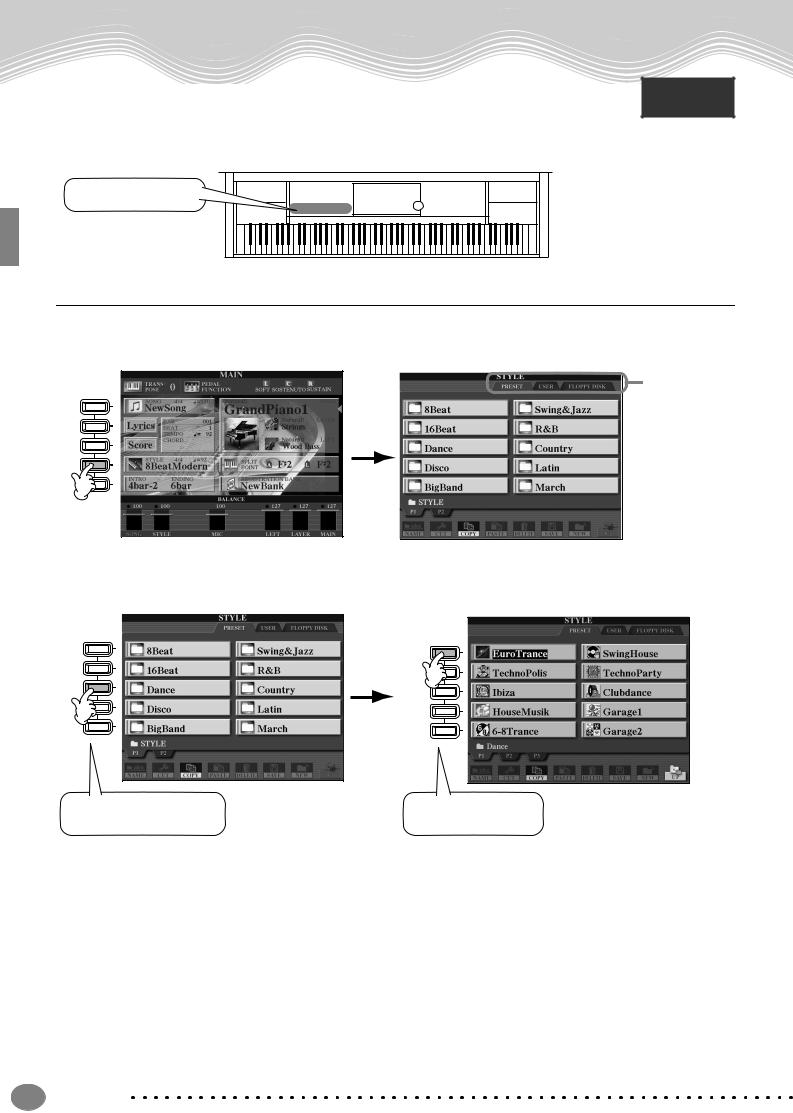
Playing Styles
Playing Styles
The Clavinova has a huge variety of musical “styles” that you can call upon to back up your own performance. They give you anything from a simple, yet effective piano backing or percussion accompaniment to a full band or orchestra.
Style related buttons
Reference on page 60
Playing a style
 1 Press the [D] button to call up the style group.
1 Press the [D] button to call up the style group.
If the MAIN screen is not displayed, press the [DIRECT ACCESS] button followed by the [EXIT] button.
A
B
C
D
E
Press the
[BACK]/[NEXT] button to select the memory location of the style. For this example, PRESET is selected.
 2 Select a style group and a style.
2 Select a style group and a style.
A
A
B
B
C
C
D
D
E
E
For this example, Dance is |
For this example, |
selected. |
EuroTrance is selected. |
28 Quick Guide
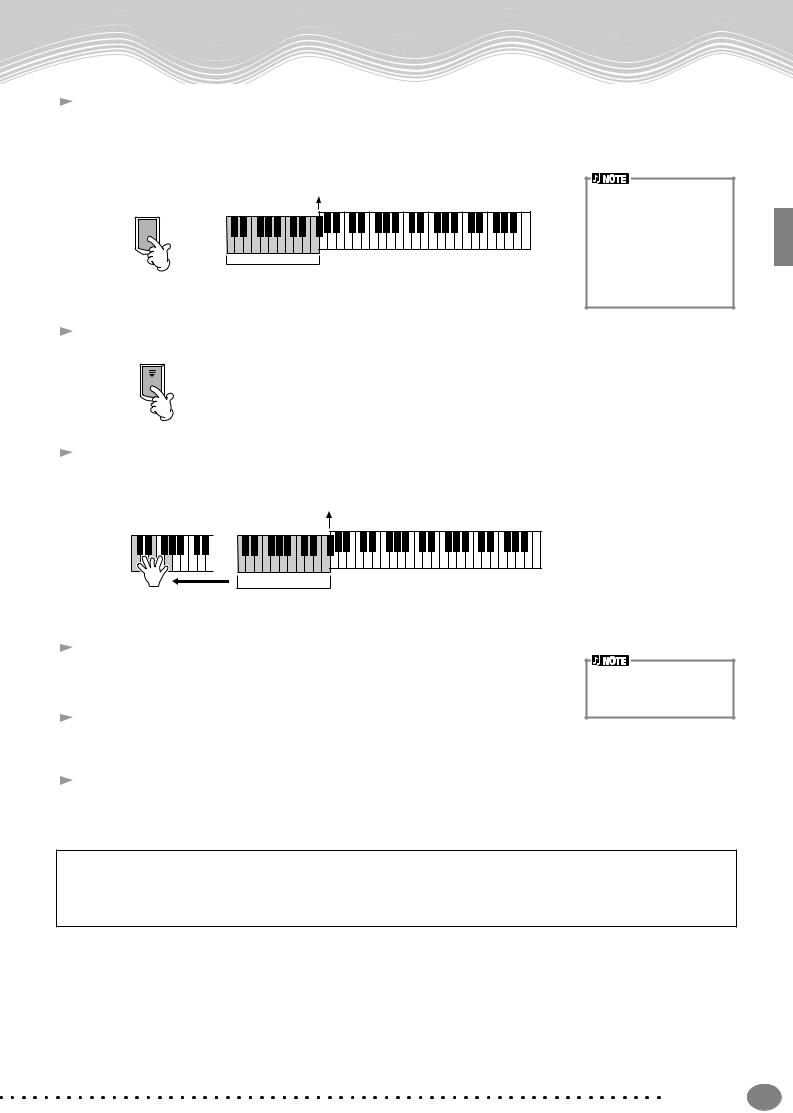
Playing Styles
 3 Turn ACMP on.
3 Turn ACMP on.
The specified left-hand section of the keyboard becomes the “Auto Accompaniment” section, and chords played in this section are automatically detected and used as a basis for fully automatic accompaniment with the selected style.
Split Point
ACMP
Auto Accompaniment
section
•The point on the keyboard that separates the auto accompaniment section and the right-hand section of the keyboard is called the “split point.” Refer to page 138 for instructions on setting the split point.
 4 Turn SYNC.START on.
4 Turn SYNC.START on.
SYNC.START
 5 As soon as you play a chord with your left hand, the style starts.
5 As soon as you play a chord with your left hand, the style starts.
For this example, play a C major chord (as shown below).
Split Point
Auto Accompaniment
section
 6 Change the tempo by using the TEMPO[
6 Change the tempo by using the TEMPO[ ] [
] [ ] buttons if necessary.
] buttons if necessary.
Simultaneously press the TEMPO [ ] [
] [ ] buttons to return the tempo to its original setting. Press the [EXIT] button to leave the TEMPO display.
] buttons to return the tempo to its original setting. Press the [EXIT] button to leave the TEMPO display.
 7 Try playing other chords with your left hand.
7 Try playing other chords with your left hand.
For information on how to enter chords, see “Chord Fingerings” on page 62.
 8 Press the STYLE [START/STOP] button to stop the style.
8 Press the STYLE [START/STOP] button to stop the style.
The Tempo can also be adjusted by using the [TAP TEMPO] button (page 52).
And there’s much more. Check out these other style-related features:
•Easily create your own original styles (page 110).
•Set up your favorite panel settings — including styles, voices, and more — and call them up whenever you need them (page 85).
Quick Guide |
29 |
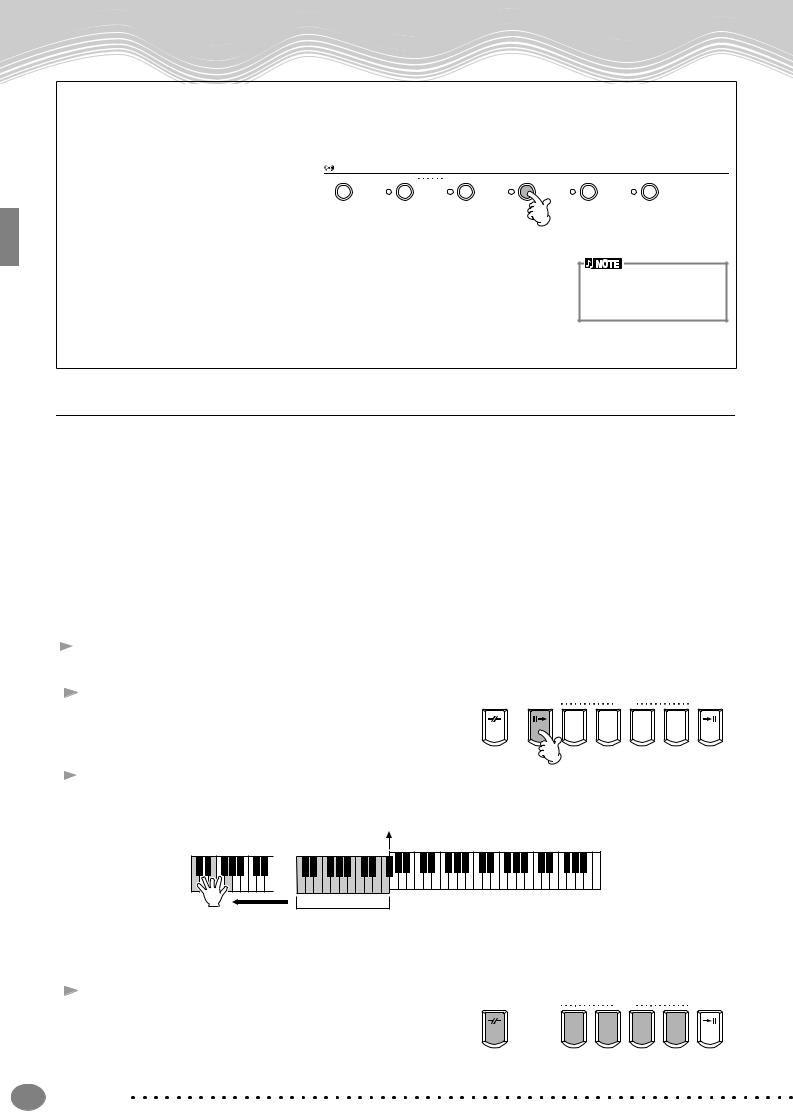
Playing Styles
Embellish and enhance your melodies — with the automatic Harmony and Echo effects
This powerful performance feature lets you automatically add harmony notes to the melodies you play with your right hand — based on the chords you play with your left. Tremolo, Echo, and other effects are available, too.
1 Turn HARMONY/ECHO on.
VOICE EFFECT
REVERB |
DSP |
VARIATION |
HARMONY / ECHO |
MONO |
LEFT HOLD |
2Turn ACMP on (page 28).
3Play a chord with your left hand and play some notes in the right-hand range of the keyboard.
The CVP-209/207 has various Harmony/Echo types (page 143).
The Harmony/Echo type may change according to the selected MAIN voice.
•Harmony/Echo is just one of the many Voice Effects you can use. Try out some of the other effects and see how they can enhance your performance (page 58).
For details about Harmony/ Echo types, refer to the separate Data List.
Style Sections
Each style in the auto accompaniment is made up of “sections.” Since each section is a rhythmic variation of the basic style, you can use them to add spice to your performance and mix up the beats — while you’re playing. Intros, Endings, Main patterns, and Breaks — they’re all here, giving you the dynamic elements you need to create professionalsounding arrangements.
INTRO |
This is used for the beginning of the song. When the intro finishes playing, accompaniment shifts to the |
|
main section. |
MAIN |
This is used for playing the main part of the song. It plays an accompaniment pattern of several measures, |
|
and repeats indefinitely until another section’s button is pressed. |
BREAK |
This lets you add dynamic variations and breaks in the rhythm of the accompaniment, to make your |
|
performance sound even more professional. |
ENDING |
This is used for the ending of the song. When the ending is finished, the auto accompaniment stops |
|
automatically. |
 1 - 4 Use the same operations as in “Playing a style” on pages 28 and 29.
1 - 4 Use the same operations as in “Playing a style” on pages 28 and 29.
5 Press the [INTRO] button. |
BREAK |
INTRO |
MAIN |
|
ENDING / rit. |
|
|
A |
B |
C |
D |
 6 As soon as you play a chord with your left hand, the Intro starts.
6 As soon as you play a chord with your left hand, the Intro starts.
For this example, play a C major chord (as shown below).
Split Point
Auto Accompaniment
section
When the playback of the intro is finished, it automatically leads into main section. |
|
|
|
||
7 Press any of the MAIN [A] to [D] buttons or [BREAK] button |
BREAK |
INTRO |
|
MAIN |
ENDING / rit. |
as desired. (See the Accompaniment Structure on the next |
|
A |
B |
C |
D |
page.) |
|
or |
|
|
|
30 Quick Guide
